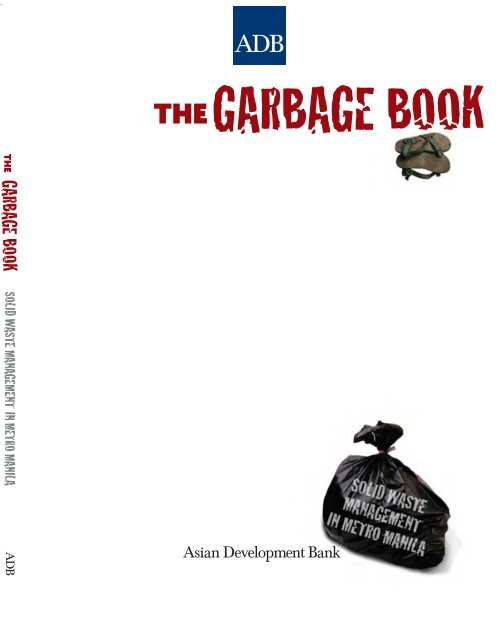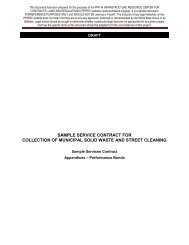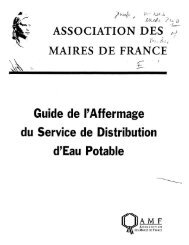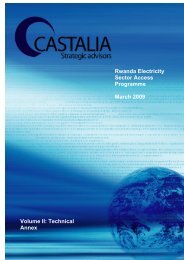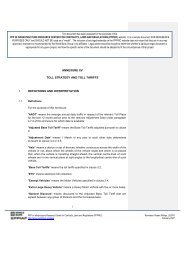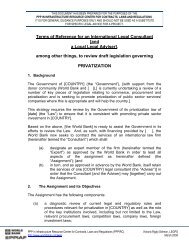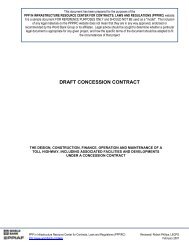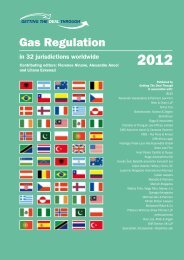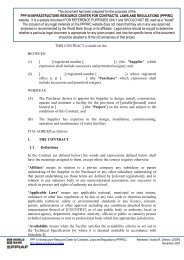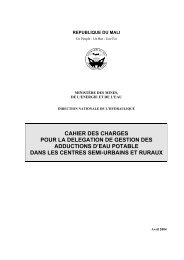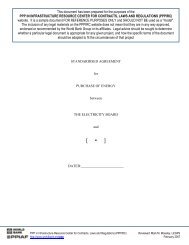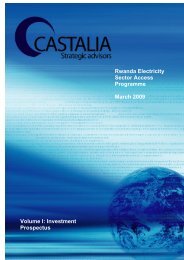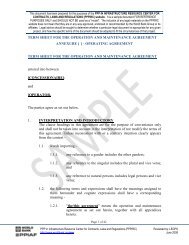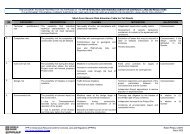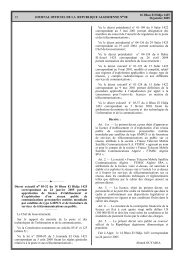the garbage book - solid waste management in metro manila.pdf
the garbage book - solid waste management in metro manila.pdf
the garbage book - solid waste management in metro manila.pdf
Create successful ePaper yourself
Turn your PDF publications into a flip-book with our unique Google optimized e-Paper software.
www.adb.org
The Garbage Book<br />
SOLID WASTE MANAGEMENT IN METRO MANILA<br />
1
Pr<strong>in</strong>ted for <strong>the</strong> Department of Environment and Natural Resources<br />
by <strong>the</strong> Asian Development Bank under TA 3848-PHI: Metro Manila<br />
Solid Waste Management Project.<br />
© 2004<br />
Asian Development Bank<br />
6 ADB Avenue, Mandaluyong City,<br />
0401 Metro Manila<br />
Philipp<strong>in</strong>es<br />
All rights reserved.<br />
First pr<strong>in</strong>ted <strong>in</strong> March 2004.<br />
The f<strong>in</strong>d<strong>in</strong>gs, <strong>in</strong>terpretations, and conclusions expressed here are<br />
those of <strong>the</strong> author(s) and do not necessarily reflect <strong>the</strong> views of<br />
<strong>the</strong> Asian Development Bank (ADB) or its member governments.<br />
ADB cannot guarantee <strong>the</strong> accuracy of <strong>the</strong> data <strong>in</strong>cluded <strong>in</strong> this<br />
publication, and accepts no responsibility whatsoever for any<br />
consequences of <strong>the</strong>ir use.<br />
The material <strong>in</strong> this work is copyrighted. No part of this work may<br />
be reproduced or transmitted <strong>in</strong> any form or by any means—<br />
electronic, mechanical, <strong>in</strong>clud<strong>in</strong>g photocopy<strong>in</strong>g, record<strong>in</strong>g, or<br />
<strong>in</strong>clusion <strong>in</strong> any <strong>in</strong>formation storage and retrieval system—without<br />
<strong>the</strong> prior permission of ADB. ADB encourages dissem<strong>in</strong>ation of its<br />
work and will normally give permission promptly and, when <strong>the</strong><br />
reproduction is for noncommercial purposes, without ask<strong>in</strong>g a fee.<br />
2
Contents<br />
Urgent Need for Change 8<br />
History of <strong>the</strong> Waste Disposal Crisis 22<br />
Waste Collection 30<br />
Waste Disposal 36<br />
Leachate 44<br />
Dangers of Dump Sites 48<br />
Waste Pick<strong>in</strong>g 50<br />
Disposal Capacity Projections 52<br />
Cost of Solid Waste 54<br />
Garbage, Poverty, and <strong>the</strong> Environment 62<br />
Payatas 64<br />
Catmon 66<br />
Pier 18 68<br />
Tanza 70<br />
Lupang Arenda 72<br />
Rodriguez 74<br />
Opportunities for Change 76<br />
RA 9003 77<br />
Community-Based Initiatives 79<br />
Recycl<strong>in</strong>g 80<br />
Compost<strong>in</strong>g 83<br />
Mov<strong>in</strong>g to Sanitary Landfills 84<br />
Action Plan for Change 86<br />
3
Eric Sales<br />
4
For most, <strong>the</strong> <strong>garbage</strong> crisis is limited to its<br />
collection. As long as <strong>the</strong> mounds of <strong>garbage</strong><br />
are removed...<br />
5
Eric Sales<br />
6
...it is a problem out of sight and out of m<strong>in</strong>d.<br />
777
Urgent Need<br />
for Change<br />
Metro Manila is a <strong>metro</strong>polis <strong>in</strong> crisis. Due to <strong>the</strong> forced closure of two primary disposal<br />
facilities, <strong>the</strong> <strong>metro</strong>polis has been without any means to adequately and safely dispose of its <strong>garbage</strong>.<br />
The <strong>solid</strong> <strong>waste</strong> <strong>management</strong> sector requires a massive and urgent overhaul. Change must come.<br />
For most, <strong>the</strong> <strong>garbage</strong> crisis is limited to its collection. As long as <strong>the</strong> mounds of <strong>garbage</strong> are<br />
removed, it is a problem out of sight and out of m<strong>in</strong>d.<br />
But <strong>the</strong> crisis cont<strong>in</strong>ues—environmentally, socially—as an unceas<strong>in</strong>g tidal wave of refuse overwhelms<br />
<strong>the</strong> <strong>metro</strong>polis. In <strong>the</strong> absence of a functional system of <strong>waste</strong> reduction, reuse, recycl<strong>in</strong>g, and<br />
disposal, local governments cope <strong>the</strong> best <strong>the</strong>y can.<br />
Eric Sales<br />
Eric Sales<br />
Eric Sales Eric Sales<br />
8
Mat<strong>the</strong>w Westfall<br />
9
Eric Sales<br />
10
Some 1,500 tons daily is<br />
dumped illegally on private land,<br />
<strong>in</strong> rivers, creeks, Manila Bay...<br />
11
Mat<strong>the</strong>w Westfall<br />
12
...or openly burned, add<strong>in</strong>g to<br />
<strong>the</strong> heavily polluted air shed.<br />
13
Of <strong>the</strong> estimated 6,700 tons generated<br />
per day, approximately 720<br />
tons per day is recycled or composted.<br />
The balance—some 6,000 tons<br />
daily—is ei<strong>the</strong>r hauled to <strong>the</strong> city’s<br />
dump sites, dumped illegally on private<br />
land, <strong>in</strong> rivers, creeks, Manila Bay, or<br />
openly burned, add<strong>in</strong>g to <strong>the</strong> heavily<br />
polluted air shed.<br />
Thousands of scavengers and<br />
<strong>waste</strong> pickers live and survive on this<br />
<strong>waste</strong>, ek<strong>in</strong>g out a harsh existence on<br />
mounta<strong>in</strong>s of smolder<strong>in</strong>g <strong>waste</strong>. Some<br />
are children as young as 5 years old.<br />
Tak<strong>in</strong>g <strong>in</strong>to account <strong>the</strong>ir families, <strong>the</strong><br />
hundreds of junk shops and <strong>the</strong>ir workers,<br />
<strong>the</strong> thousands of eco-aides, <strong>the</strong><br />
thousands of <strong>garbage</strong> trucks and <strong>the</strong>ir<br />
crews, and <strong>the</strong> tens of thousands of<br />
slum dwellers liv<strong>in</strong>g on, around, and<br />
near <strong>the</strong> dump sites, an estimated<br />
150,000 residents of Metro Manila<br />
know <strong>the</strong> sight and smell of <strong>garbage</strong> as<br />
an <strong>in</strong>tegral part of <strong>the</strong>ir daily lives.<br />
Mat<strong>the</strong>w Westfall<br />
Ram Cabrera<br />
14
Eric Sales<br />
Eric Sales<br />
Eric Sales<br />
Eric Sales<br />
Eric Sales<br />
16
...an estimated 150,000 residents of Metro<br />
Manila know <strong>the</strong> sight and smell of <strong>garbage</strong><br />
as an <strong>in</strong>tegral part of <strong>the</strong>ir daily lives.<br />
Mat<strong>the</strong>w Westfall<br />
Ram Cabrera<br />
17
Ram Cabrera<br />
Ram Cabrera<br />
In July 2000, after a weekend of heavy ra<strong>in</strong>,<br />
a mounta<strong>in</strong> of <strong>garbage</strong> collapsed, bury<strong>in</strong>g<br />
hundreds of homes.<br />
The severity of Metro Manila’s <strong>garbage</strong><br />
crisis is illustrated by <strong>the</strong> Payatas dump site<br />
tragedy. In July 2000, after a weekend of heavy<br />
ra<strong>in</strong>, a mounta<strong>in</strong> of <strong>garbage</strong> collapsed, bury<strong>in</strong>g<br />
hundreds of homes. Later, due to a dangerous<br />
mix of methane gas and downed electrical utility<br />
poles, fires spread across <strong>the</strong> dump site.<br />
The bodies of 205 people were recovered and,<br />
reportedly, hundreds more rema<strong>in</strong> miss<strong>in</strong>g.<br />
In December 2000, <strong>the</strong> site was “permanently<br />
closed,” with plans to fast-track a new<br />
sanitary landfill project. A crisis <strong>in</strong> collection ensued,<br />
with mounta<strong>in</strong>s of <strong>garbage</strong> left uncollected<br />
throughout <strong>the</strong> <strong>metro</strong>polis. Over time, without any<br />
alternatives <strong>in</strong> place, dump<strong>in</strong>g at Payatas has<br />
resumed.<br />
Ram Cabrera<br />
18
Garbage Everywhere<br />
22 October 2001<br />
Philipp<strong>in</strong>e Daily Inquirer Editorial<br />
Forget about anthrax. Forget about<br />
bioterrorism. We are not go<strong>in</strong>g to die from<br />
<strong>the</strong>se th<strong>in</strong>gs. The people of Metro Manila are<br />
fac<strong>in</strong>g much more lethal, much more immediate<br />
threats to <strong>the</strong>ir health and well-be<strong>in</strong>g.<br />
These threats come from <strong>the</strong> mounta<strong>in</strong>s of<br />
<strong>garbage</strong> that dot almost every o<strong>the</strong>r block of<br />
<strong>the</strong> <strong>metro</strong>polis.<br />
Metro Manila’s dump sites are<br />
dangerous, exposed, and generate potentially<br />
toxic liquids called “leachate.”<br />
As <strong>the</strong>se tox<strong>in</strong>s flow along <strong>the</strong> surface<br />
and seep <strong>in</strong>to <strong>the</strong> earth, <strong>the</strong>y risk poison<strong>in</strong>g<br />
<strong>the</strong> surface and groundwater<br />
that are used for dr<strong>in</strong>k<strong>in</strong>g, aquatic life,<br />
and <strong>the</strong> environment. Waste fires at<br />
<strong>the</strong>se sites are common, which send<br />
plumes of toxic emissions <strong>in</strong>to <strong>the</strong> air.<br />
O<strong>the</strong>r sites are critically unstable, present<strong>in</strong>g<br />
<strong>the</strong> possibility of ano<strong>the</strong>r<br />
deadly <strong>garbage</strong> slide.<br />
The majority of Metro Manila’s<br />
dump sites will reach capacity dur<strong>in</strong>g<br />
2004. The likely result may be ano<strong>the</strong>r<br />
visible crisis <strong>in</strong> collection and <strong>the</strong> hurried<br />
expansion of rema<strong>in</strong><strong>in</strong>g sites. In<br />
this haste, longer-term, more susta<strong>in</strong>able<br />
solutions may be ignored.<br />
Despite <strong>the</strong> promotion of <strong>waste</strong><br />
segregation and collection at source,<br />
adoption has been at a very slow pace.<br />
Efforts must be dramatically scaled up<br />
to have any effect on <strong>the</strong> unceas<strong>in</strong>g<br />
wave of <strong>garbage</strong> generated by Metro<br />
Manila.<br />
The not-<strong>in</strong>-my-backyard (NIMBY)<br />
phenomenon is hard at work <strong>in</strong> Metro<br />
Manila. Despite numerous efforts, no<br />
community has been will<strong>in</strong>g to take<br />
Metro Manila’s <strong>garbage</strong>. A survey<br />
found that while 67% of residents believed<br />
that Metro Manila has a serious<br />
<strong>garbage</strong> problem, 73% did not want to<br />
see a sanitary landfill <strong>in</strong> <strong>the</strong>ir community.<br />
Notably, 78% of surveyed house-<br />
Metro Manila’s dump sites<br />
are dangerous, exposed, and<br />
generate potentially toxic<br />
liquids called ‘leachate’.<br />
Eric Sales<br />
19
The Surat, India<br />
Experience<br />
In September 1994, nearly 30 years after<br />
<strong>the</strong> last urban outbreak <strong>in</strong> India, plague<br />
struck Surat, a city <strong>in</strong> western India. This<br />
served as a chill<strong>in</strong>g rem<strong>in</strong>der of how rapid<br />
urbanization and deterioration of <strong>the</strong> urban<br />
environment can br<strong>in</strong>g people <strong>in</strong>to contact<br />
with forgotten diseases. Pneumonic plague,<br />
a highly contagious form of <strong>the</strong> disease, kills<br />
100% of its victims if left untreated. Crowd<strong>in</strong>g<br />
and poor sanitation provide ideal conditions<br />
for its spread. Because it is so<br />
contagious, <strong>the</strong> outbreak caused extreme<br />
panic locally and <strong>in</strong>ternationally, with one<br />
quarter of <strong>the</strong> populace flee<strong>in</strong>g <strong>the</strong> city.<br />
Fortunately, <strong>the</strong> outbreak was diagnosed<br />
quickly, widespread treatment began, and<br />
<strong>the</strong> death rate dropped dramatically.<br />
Why y an Epidemic?<br />
Evidence po<strong>in</strong>ts to <strong>the</strong> squalid conditions <strong>in</strong><br />
much of Surat and <strong>the</strong> occurrence of two<br />
natural disasters, an earthquake and heavy<br />
flood<strong>in</strong>g, which brought plague-<strong>in</strong>fected<br />
rats <strong>in</strong>to contact with <strong>the</strong> human population.<br />
Surat’s sanitation problems <strong>the</strong>n helped <strong>the</strong><br />
rat population grow dramatically. A city of<br />
2.2 million, Surat generates close to 1,250<br />
tons of <strong>garbage</strong> each day, 250 tons of which<br />
rema<strong>in</strong> uncollected. To make matters worse,<br />
monsoon floodwaters <strong>in</strong>undated <strong>the</strong> city,<br />
particularly low-ly<strong>in</strong>g slum areas.<br />
Death Toll and Damage<br />
to o <strong>the</strong> Indian Economy<br />
In relative terms, <strong>the</strong> death toll of 56 persons<br />
was m<strong>in</strong>or. By any o<strong>the</strong>r name, <strong>the</strong><br />
plague probably would not have caused <strong>the</strong><br />
k<strong>in</strong>d of panic that it did. In f<strong>in</strong>ancial terms,<br />
however, <strong>the</strong> plague’s toll was much greater,<br />
cost<strong>in</strong>g <strong>the</strong> Indian economy <strong>in</strong> excess of<br />
$600 million. More than 45,000 people<br />
canceled <strong>the</strong>ir travel plans to India, and <strong>the</strong><br />
country’s hotel occupancy rate dipped to<br />
20% from 60%. Many countries stopped air<br />
and water traffic to India, while exports<br />
suffered a $420 million loss.<br />
World Resources Institute, World Resources<br />
1996-97<br />
Ram Cabrera<br />
holds had no idea where <strong>the</strong>ir collected<br />
<strong>garbage</strong> was taken for f<strong>in</strong>al disposal.<br />
Medical <strong>waste</strong> <strong>management</strong> presents<br />
ano<strong>the</strong>r challenge. Nearly 3,700<br />
health care facilities <strong>in</strong> Metro Manila generate<br />
an estimated 47 tons of medical<br />
<strong>waste</strong> per day, with 56% of this <strong>waste</strong>, or<br />
26 tons, considered potentially <strong>in</strong>fectious.<br />
A significant proportion of this dangerous<br />
<strong>waste</strong> f<strong>in</strong>ds its way <strong>in</strong>to <strong>the</strong> municipal<br />
<strong>waste</strong> stream, and is handled by<br />
people who are poorly equipped and<br />
tra<strong>in</strong>ed, expos<strong>in</strong>g <strong>the</strong>m to <strong>in</strong>fections and<br />
o<strong>the</strong>r health hazards.<br />
The problem of medical <strong>waste</strong> disposal<br />
is fur<strong>the</strong>r exacerbated by <strong>the</strong> mandated<br />
closure of medical <strong>waste</strong> <strong>in</strong>c<strong>in</strong>erators<br />
<strong>in</strong> hospitals <strong>in</strong> Metro Manila, as required<br />
by <strong>the</strong> Clean Air Act. No alternative<br />
is <strong>in</strong> place.<br />
Aga<strong>in</strong>st this grim context, a major<br />
accomplishment has been <strong>the</strong> passage<br />
of Republic Act 9003—<strong>the</strong> Ecological<br />
Solid Waste Management Act of 2000.<br />
While a good beg<strong>in</strong>n<strong>in</strong>g, much work<br />
rema<strong>in</strong>s to be done. Despite <strong>the</strong> simplicity<br />
of its prescription—reduce, reuse,<br />
and recycle at <strong>the</strong> local level—<strong>the</strong><br />
law awaits serious implementation.<br />
RA 9003 is an enlightened piece of<br />
legislation, yet few local governments are<br />
familiar with it. The timetable is beh<strong>in</strong>d<br />
schedule, source reduction and segregation<br />
efforts at <strong>the</strong> local level are sporadic<br />
and uneven, and <strong>the</strong>re is little active<br />
public participation, understand<strong>in</strong>g, or<br />
<strong>in</strong>terest. Significantly, <strong>the</strong> required Solid<br />
Waste Management Fund has not been<br />
set aside as mandated by law, limit<strong>in</strong>g<br />
<strong>the</strong> level of <strong>in</strong>vestment.<br />
20
We owe it to <strong>the</strong><br />
next generation<br />
to resolve this<br />
crisis now.<br />
The <strong>garbage</strong> bus<strong>in</strong>ess is lucrative.<br />
Over P3.54 billion is spent annually on<br />
<strong>waste</strong> collection and disposal. Yet despite<br />
<strong>the</strong> amount of money <strong>in</strong> <strong>the</strong> system,<br />
it does not function <strong>in</strong> a safe,<br />
susta<strong>in</strong>able way.<br />
The <strong>garbage</strong> crisis is real, serious,<br />
and poses even grave threats to public<br />
health if not resolved. The root causes<br />
of <strong>the</strong> problems are not technical or<br />
f<strong>in</strong>ancial, but ra<strong>the</strong>r relate to governance<br />
and political will.<br />
We owe it to <strong>the</strong> next generation to<br />
resolve this crisis now.<br />
Eric Sales<br />
21
History of <strong>the</strong><br />
Waste Disposal<br />
Crisis<br />
The Rise (Early 1991–Mid-1992): Early 1991 marked an important<br />
transition <strong>in</strong> Metro Manila <strong>waste</strong> disposal. Prior to this, <strong>the</strong> <strong>metro</strong>polis<br />
operated numerous dump sites, <strong>in</strong>clud<strong>in</strong>g <strong>the</strong> <strong>in</strong>ternationally <strong>in</strong>famous<br />
Smokey Mounta<strong>in</strong> dump site <strong>in</strong> <strong>the</strong> City of Manila. In 1991, and as a<br />
result of mount<strong>in</strong>g public pressure to improve <strong>waste</strong> disposal and close<br />
Smokey Mounta<strong>in</strong>, <strong>the</strong> World Bank-f<strong>in</strong>anced 73-hectare (ha) regional<br />
sanitary landfill facility opened <strong>in</strong> San Mateo, Rizal. This was followed <strong>in</strong><br />
1992 with <strong>the</strong> open<strong>in</strong>g of <strong>the</strong> 65-ha Carmona regional sanitary landfill<br />
<strong>in</strong> Cavite, which co<strong>in</strong>cided with <strong>the</strong> closure of Smokey Mounta<strong>in</strong>. Both<br />
facilities were designed and constructed to <strong>in</strong>ternational standards and<br />
represented a major accomplishment for <strong>the</strong> Government. Several large<br />
dump sites also operated dur<strong>in</strong>g <strong>the</strong> early 1990s, <strong>in</strong>clud<strong>in</strong>g <strong>the</strong> Payatas<br />
and Catmon dump sites.<br />
The Decl<strong>in</strong>e (Mid-1992–Late<br />
1997): Over time, operations at San<br />
Mateo and Carmona progressively impacted<br />
local communities. Design,<br />
construction, and operation standards<br />
decl<strong>in</strong>ed with each operational phase,<br />
rais<strong>in</strong>g concerns about environmental<br />
risks. Hundreds of trucks thundered<br />
through communities nightly, strew<strong>in</strong>g<br />
<strong>garbage</strong> <strong>in</strong> <strong>the</strong>ir wake. The presence of<br />
junk shops, <strong>waste</strong> pickers, and <strong>in</strong>formal<br />
shanties brought social impacts. Public<br />
opposition mounted.<br />
Disposal operations cont<strong>in</strong>ued at<br />
<strong>the</strong> ever-grow<strong>in</strong>g Payatas and Catmon<br />
dump sites, as well as at <strong>the</strong> Doña<br />
Petra dump site <strong>in</strong> Marik<strong>in</strong>a, and <strong>the</strong><br />
C4 dump site <strong>in</strong> Navotas. Dump<strong>in</strong>g activities<br />
commenced at <strong>the</strong> Lupang<br />
Arenda dump site on <strong>the</strong> north shore of<br />
Laguna de Bay.<br />
Bot Patena<br />
Ram Cabrera<br />
22
Eric Sales<br />
Hundreds of trucks thundered through communities<br />
nightly, strew<strong>in</strong>g <strong>garbage</strong> <strong>in</strong> <strong>the</strong>ir wake. The presence<br />
of junk shops, <strong>waste</strong> pickers, and <strong>in</strong>formal shanties<br />
brought social impacts. Public opposition mounted.<br />
23
Eric Sales<br />
The impend<strong>in</strong>g crisis led to <strong>the</strong> open<strong>in</strong>g of<br />
<strong>the</strong> L<strong>in</strong>gunan dump site <strong>in</strong> Valenzuela, and <strong>the</strong><br />
stockpil<strong>in</strong>g of <strong>waste</strong> at Pier 18 <strong>in</strong> Manila.<br />
24<br />
24
Metro Manila was out of options<br />
for disposal, and <strong>waste</strong> went largely<br />
uncollected.<br />
Eric Sales<br />
Prelude to Crisis (Late 1997–<br />
Late 1999): In early 1998, heightened<br />
public opposition forced <strong>the</strong> suspension<br />
of operations at Carmona. This<br />
placed <strong>in</strong>creas<strong>in</strong>g pressure on San<br />
Mateo and major dump sites to accommodate<br />
<strong>the</strong> additional <strong>waste</strong>. The impend<strong>in</strong>g<br />
crisis led to <strong>the</strong> open<strong>in</strong>g of <strong>the</strong><br />
L<strong>in</strong>gunan dump site <strong>in</strong> Valenzuela, and<br />
<strong>the</strong> stockpil<strong>in</strong>g of <strong>waste</strong> at Pier 18 <strong>in</strong><br />
Manila. Dur<strong>in</strong>g 1998, <strong>waste</strong> disposal<br />
options were fur<strong>the</strong>r limited by <strong>the</strong> passage<br />
of <strong>the</strong> Clean Air Act, which effectively<br />
stalled plans to build <strong>in</strong>c<strong>in</strong>erators.<br />
Two major donor-funded studies<br />
were also completed dur<strong>in</strong>g this period,<br />
one of which evaluated toxic and hazardous<br />
<strong>waste</strong>, and ano<strong>the</strong>r that developed<br />
a <strong>metro</strong>-wide master plan for<br />
<strong>solid</strong> <strong>waste</strong>. The recommendations of<br />
<strong>the</strong>se studies were not implemented,<br />
even though one warned of an impend<strong>in</strong>g<br />
disposal crisis.<br />
Mat<strong>the</strong>w Westfall<br />
Eric Sales<br />
The Crisis (Late 1999–Early 2001):<br />
The <strong>waste</strong> disposal crisis was a sudden<br />
phenomenon, marked by <strong>the</strong> forced<br />
suspension of operations of <strong>the</strong> San<br />
Mateo sanitary landfill <strong>in</strong> late 1999 due<br />
to immense public opposition. With<strong>in</strong><br />
weeks, it brought about a near-catastrophic<br />
collapse of <strong>the</strong> municipal<br />
<strong>waste</strong> system and severe public health<br />
risks. Metro Manila was out of options<br />
for disposal, and <strong>waste</strong> went largely<br />
uncollected. Dump<strong>in</strong>g at <strong>the</strong> exist<strong>in</strong>g<br />
sites was accelerated, and small-scale,<br />
private dump sites were developed.<br />
As <strong>the</strong> Government searched for<br />
immediate relief, private sector <strong>in</strong>itiatives<br />
were hastily conceived. These <strong>in</strong>cluded<br />
plans to barge <strong>waste</strong> to Bataan<br />
to <strong>the</strong> northwest and Semirara Island<br />
to <strong>the</strong> south. Both plans met fierce<br />
public opposition, and follow<strong>in</strong>g <strong>the</strong><br />
issuance of legal restra<strong>in</strong><strong>in</strong>g orders,<br />
were curtailed. The Government also<br />
sponsored a procurement process to<br />
select a private sector consortium to<br />
develop an <strong>in</strong>tegrated <strong>waste</strong> <strong>management</strong><br />
system, <strong>in</strong>clud<strong>in</strong>g a disposal facility<br />
<strong>in</strong> Rizal. This also encountered public<br />
opposition and a legal restra<strong>in</strong><strong>in</strong>g<br />
order, and <strong>the</strong> plan rema<strong>in</strong>s stalled to<br />
this day.<br />
Uncontrolled dump<strong>in</strong>g at <strong>the</strong><br />
Payatas dump site led to a catastrophic<br />
<strong>waste</strong> mass failure at <strong>the</strong> site <strong>in</strong> July<br />
2000. The tragedy signified <strong>the</strong> scale<br />
of <strong>the</strong> crisis.<br />
Subsequently, Payatas was temporarily<br />
closed, only to reopen later. O<strong>the</strong>r<br />
smaller dump sites struggled to cope<br />
with <strong>the</strong> <strong>in</strong>creased <strong>waste</strong> stream.<br />
Waste from <strong>the</strong> City of Manila cont<strong>in</strong>ued<br />
to pile up at Pier 18.<br />
25
Mat<strong>the</strong>w Westfall<br />
S<strong>in</strong>ce 2001, additional controlled dump<br />
sites have been developed <strong>in</strong><br />
an attempt to mitigate <strong>the</strong> crisis.<br />
The Aftermath (Early 2001–<br />
Present): S<strong>in</strong>ce 2001, additional<br />
controlled dump sites have been<br />
developed <strong>in</strong> an attempt to<br />
mitigate <strong>the</strong> crisis. These <strong>in</strong>clude<br />
<strong>the</strong> Rodriguez disposal facility <strong>in</strong><br />
Montalban and <strong>the</strong> Tanza facility <strong>in</strong><br />
Navotas. RA 9003 was also enacted<br />
dur<strong>in</strong>g this time.<br />
A widely held perception is<br />
that <strong>the</strong> crisis has subsided, and that<br />
longer-term <strong>waste</strong> disposal issues have<br />
been solved. This, unfortunately, is far<br />
from reality.<br />
Metro Manila has less than 2 years<br />
disposal capacity, assum<strong>in</strong>g optimistic<br />
estimates. The potential for ano<strong>the</strong>r<br />
<strong>waste</strong> disposal crisis is high unless<br />
immediate action is taken.<br />
Without doubt, current <strong>waste</strong><br />
disposal practices pose significant public<br />
health, environmental, and<br />
social risks. Over <strong>the</strong> short term, ano<strong>the</strong>r<br />
tragedy like Payatas is possible,<br />
while long-term and <strong>in</strong>creas<strong>in</strong>gly costly<br />
damage to <strong>the</strong> environment is a certa<strong>in</strong>ty.<br />
Mat<strong>the</strong>w Westfall<br />
26
Metro Manila has less than 2 years<br />
disposal capacity, assum<strong>in</strong>g optimistic<br />
estimates.<br />
27
DoubleSlash<br />
28
Waste<br />
Collection<br />
Under RA 9003, <strong>the</strong> local government is responsible for<br />
collect<strong>in</strong>g nonrecyclable materials and special <strong>waste</strong>s, while<br />
barangay units are given <strong>the</strong> task and responsibility of<br />
collect<strong>in</strong>g and segregat<strong>in</strong>g <strong>the</strong> biodegradable, compostable,<br />
and reusable <strong>waste</strong>s. Of Metro Manila’s 17 cities and<br />
municipalities, 11 contract out <strong>garbage</strong> collection to <strong>the</strong> private<br />
sector and 6 collect <strong>garbage</strong> <strong>the</strong>mselves as part of <strong>the</strong>ir<br />
local government functions.<br />
Eric Sales<br />
Eric Sales<br />
Eric Sales<br />
30
DoubleSlash<br />
32
The common collection practice<br />
is through house-to-house<br />
collection. Many local governments<br />
have detailed local plans<br />
cover<strong>in</strong>g <strong>waste</strong> collection<br />
services, and detailed route<br />
maps for collection vehicles.<br />
Mat<strong>the</strong>w Westfall<br />
Mat<strong>the</strong>w Westfall<br />
34
Of Metro Manila’s 17 cities and municipalities, 11 contract out<br />
<strong>garbage</strong> collection to <strong>the</strong> private sector and 6 collect <strong>garbage</strong><br />
<strong>the</strong>mselves as part of <strong>the</strong>ir local government functions.<br />
Marik<strong>in</strong>a<br />
Marik<strong>in</strong>a City has a separated <strong>waste</strong> collection service with<strong>in</strong> its<br />
barangays. The city collects <strong>solid</strong> <strong>waste</strong>s from households, markets,<br />
and commercial establishments, with two trucks travel<strong>in</strong>g<br />
<strong>in</strong> tandem collect<strong>in</strong>g biodegradable or nonbiodegradable<br />
<strong>waste</strong>s. The nonbiodegradable fraction is taken to <strong>the</strong> recycl<strong>in</strong>g<br />
station for sort<strong>in</strong>g, where workers extract materials utiliz<strong>in</strong>g a<br />
mechanized conveyor system. Recyclable materials are <strong>the</strong>n<br />
placed <strong>in</strong> large b<strong>in</strong>s for temporary storage before be<strong>in</strong>g transferred<br />
to downstream private recyclers for eventual fur<strong>the</strong>r process<strong>in</strong>g<br />
and reuse. The biodegradable fraction is taken to <strong>the</strong><br />
disposal site where it is spread, compacted, and covered with<br />
soil. The barangays are not allowed to collect recyclable materials,<br />
except for tree cutt<strong>in</strong>gs and garden and yard <strong>waste</strong>s. The<br />
dump site is <strong>in</strong> <strong>the</strong> process of be<strong>in</strong>g closed.<br />
Pasay City<br />
Pasay City’s <strong>waste</strong> collection and disposal is undertaken through<br />
private sector “total package” contracts. The contractors are responsible<br />
for <strong>the</strong> entire collection, transfer, and disposal of <strong>waste</strong>s.<br />
The city is divided <strong>in</strong>to five sectors, for which <strong>the</strong> number of truck<br />
trips has been agreed between <strong>the</strong> city and <strong>the</strong> contractors. Four<br />
contractors run a total of 102 truck trips. The contractors dump<br />
“wherever <strong>the</strong>y can,” <strong>in</strong>clud<strong>in</strong>g Rodriguez, Montalban. Transfer and<br />
disposal are considered “expensive, tak<strong>in</strong>g up to 4 hours per load,<br />
and cost<strong>in</strong>g up to P1,500 ($27) per truck for tipp<strong>in</strong>g fees at private<br />
dump sites.”<br />
Current Collection and Disposal System<br />
Local<br />
Government<br />
Unit<br />
Collection<br />
Reported<br />
Coverage<br />
(%)<br />
Own<br />
Disposal<br />
Facility<br />
Reported<br />
Waste Disposal<br />
Location<br />
Caloocan<br />
Las Piñas<br />
Makati<br />
Malabon<br />
Mandaluyong<br />
Manila<br />
Marik<strong>in</strong>a<br />
Munt<strong>in</strong>lupa<br />
Navotas<br />
Parañaque<br />
Pasay<br />
Pasig<br />
Pateros<br />
Quezon City<br />
San Juan<br />
Taguig<br />
Valenzuela<br />
Contract<br />
Adm<strong>in</strong>istration<br />
Contract<br />
Adm<strong>in</strong>istration<br />
Contract<br />
Contract<br />
Adm<strong>in</strong>istration<br />
Contract<br />
Contract<br />
Contract<br />
Contract<br />
Contract<br />
Contract/<br />
MMDA<br />
Contract<br />
Contract<br />
Contract<br />
Adm<strong>in</strong>istration<br />
80<br />
95<br />
100<br />
100<br />
85<br />
95<br />
100<br />
90<br />
80<br />
Yes<br />
No<br />
No<br />
Yes<br />
No<br />
No<br />
Yes<br />
No<br />
Yes<br />
Yes<br />
No<br />
No<br />
Yes<br />
No<br />
No<br />
Yes<br />
Rodriguez<br />
Pulang Lupa<br />
Rodriguez<br />
Catmon<br />
Rodriguez<br />
Rodriguez<br />
Doña Petra<br />
Rodriguez<br />
Rodriguez<br />
San Pedro<br />
Bacoor<br />
Tanza<br />
San Pedro<br />
Rodriguez<br />
San Pedro<br />
Rodriguez<br />
Taytay<br />
Payatas<br />
Rodriguez<br />
Payatas<br />
Rodriguez<br />
Rodriguez<br />
L<strong>in</strong>gunan<br />
35
Waste<br />
Disposal<br />
Waste disposal is a necessary part of an<br />
<strong>in</strong>tegrated system for manag<strong>in</strong>g <strong>solid</strong> <strong>waste</strong>, one <strong>in</strong> which<br />
<strong>waste</strong> m<strong>in</strong>imization and recycl<strong>in</strong>g <strong>in</strong>itiatives should be<br />
prioritized. At <strong>the</strong> same time, practical and achievable <strong>waste</strong><br />
disposal improvements are required to reduce <strong>the</strong> acute<br />
public health, environmental, and social impacts caused by<br />
exist<strong>in</strong>g dump<strong>in</strong>g practices.<br />
Accurate eng<strong>in</strong>eer<strong>in</strong>g and o<strong>the</strong>r technical data are<br />
virtually absent for exist<strong>in</strong>g disposal facilities and practices,<br />
and an assessment can only be prepared from cursory site<br />
observations and verbal site reports. Never<strong>the</strong>less, Metro<br />
Manila must act immediately to improve <strong>waste</strong> disposal<br />
practices and establish sanitary landfill facilities <strong>in</strong> accordance<br />
with RA 9003. Until this is achieved, <strong>waste</strong> dump<strong>in</strong>g<br />
will cont<strong>in</strong>ue to cause serious public health, environmental,<br />
and social damage.<br />
Mat<strong>the</strong>w Westfall<br />
Eric Sales<br />
36
DoubleSlash<br />
38
DoubleSlash<br />
40
DoubleSlash<br />
42
Leachate<br />
Samples of liquid runoff, or leachate, from <strong>the</strong><br />
Rodriguez and Payatas dump sites were tested and<br />
were found to have levels of contam<strong>in</strong>ants that were<br />
far above <strong>the</strong> maximum allowed <strong>in</strong> dr<strong>in</strong>k<strong>in</strong>g<br />
water. Most of this leachate seeps untreated <strong>in</strong>to<br />
groundwater, a source of dr<strong>in</strong>k<strong>in</strong>g water, and runs <strong>in</strong>to<br />
<strong>the</strong> Marik<strong>in</strong>a and Pasig River systems, and Manila Bay,<br />
a fisheries resource. The risks to human health are<br />
enormous.<br />
Eric Sales<br />
Mat<strong>the</strong>w Westfall<br />
Mat<strong>the</strong>w Westfall<br />
Eric Sales<br />
44
Lead: Lead levels <strong>in</strong> <strong>the</strong><br />
samples were found to be up to<br />
22 times above standards.<br />
Lead poison<strong>in</strong>g is a lead<strong>in</strong>g environmentally<br />
<strong>in</strong>duced illness <strong>in</strong><br />
children, caus<strong>in</strong>g decreased<br />
mental abilities, learn<strong>in</strong>g difficulties,<br />
and reduced growth.<br />
Lead can affect almost every<br />
organ and system <strong>in</strong> <strong>the</strong> human<br />
body. The most sensitive is <strong>the</strong><br />
central nervous system. Lead<br />
also damages kidneys and <strong>the</strong><br />
human reproductive system.<br />
Unborn children can be exposed<br />
to lead through <strong>the</strong>ir<br />
mo<strong>the</strong>rs.<br />
Mat<strong>the</strong>w Westfall<br />
Fecal Coliform: Not necessarily<br />
a health threat <strong>in</strong> itself,<br />
this measure is used to<br />
<strong>in</strong>dicate whe<strong>the</strong>r potentially<br />
harmful bacteria may be<br />
present, and is generally<br />
due to feces. The high levels<br />
of fecal coliform confirms<br />
<strong>the</strong> presence of a large<br />
amount of human <strong>waste</strong> <strong>in</strong><br />
<strong>the</strong> dump sites and surround<strong>in</strong>g<br />
areas, which is<br />
presumably generated by<br />
households that lack alternatives<br />
to sanitation.<br />
In <strong>the</strong> samples tested,<br />
fecal coliform values were<br />
found to be an average of<br />
7 million, with a high of<br />
30 million, <strong>in</strong>dicat<strong>in</strong>g significant<br />
contam<strong>in</strong>ation. Risks to<br />
<strong>waste</strong> pickers and o<strong>the</strong>rs<br />
who handle this <strong>waste</strong> are<br />
significant.<br />
Nitrogen: Total nitrogen<br />
levels of <strong>the</strong> tested samples<br />
were elevated up to 32<br />
times over safe levels. Infants<br />
below <strong>the</strong> age of 6<br />
months who dr<strong>in</strong>k water<br />
conta<strong>in</strong><strong>in</strong>g nitrite, a subset<br />
of total nitrogen, <strong>in</strong> excess<br />
of safe levels can become<br />
seriously ill and, if untreated,<br />
may die. Symptoms<br />
<strong>in</strong>clude shortness of breath<br />
and blue-baby syndrome.<br />
Biochemical Oxygen<br />
Demand (BOD): High BOD<br />
levels that enter surface<br />
waters will deplete dissolved<br />
oxygen necessary to support<br />
fish and o<strong>the</strong>r aquatic organisms.<br />
Generally, water<br />
with BOD levels of 100 parts<br />
per million (ppm) or greater<br />
is considered very polluted.<br />
In <strong>the</strong> samples tested, BOD<br />
levels were up to 98 times<br />
above this very polluted<br />
level.<br />
Arsenic: Arsenic levels were<br />
found to be 60 times above<br />
maximum safe levels, with a<br />
high of 84 times above safe<br />
standards. Potential health<br />
effects from contact or <strong>in</strong>gest<strong>in</strong>g<br />
arsenic <strong>in</strong>cludes sk<strong>in</strong><br />
damage, circulatory system<br />
problems, and an <strong>in</strong>creased<br />
risk of cancer.<br />
O<strong>the</strong>r Dangerous<br />
Contam<strong>in</strong>ants: While not<br />
<strong>in</strong>dicated <strong>in</strong> <strong>the</strong> limited sampl<strong>in</strong>g<br />
taken from <strong>the</strong>se two<br />
sites, leachate from municipal<br />
landfills is highly variable<br />
and typically conta<strong>in</strong>s high<br />
concentrations of many<br />
o<strong>the</strong>r dangerous contam<strong>in</strong>ants,<br />
such as heavy metals<br />
(z<strong>in</strong>c, copper, barium, manganese,<br />
cadmium, and chromium),<br />
hazardous organics,<br />
and possibly stra<strong>in</strong>s of opportunistic<br />
pathogens.<br />
45
Based on leachate sampl<strong>in</strong>g,<br />
Rodriguez and Payatas generate an<br />
estimated 26 kilograms of lead and<br />
76 kilograms of arsenic annually...<br />
Mat<strong>the</strong>w Westfall<br />
46
...which is released <strong>in</strong>to <strong>the</strong> groundwater,<br />
rivers, lakes, and bay of Metro Manila.<br />
47
DoubleSlash<br />
48
Waste Pick<strong>in</strong>g<br />
One of <strong>the</strong> most serious concerns of<br />
<strong>the</strong> current dump site operations is <strong>the</strong><br />
presence and operations of <strong>waste</strong> pickers<br />
and scavengers. Over 4,300 <strong>waste</strong><br />
pickers operate at <strong>the</strong> dump sites,<br />
work<strong>in</strong>g <strong>in</strong> dangerous and filthy conditions.<br />
They are poorly organized and<br />
largely unprotected aga<strong>in</strong>st <strong>the</strong> dangers<br />
of <strong>waste</strong> handl<strong>in</strong>g. Children, as young<br />
as 5 years, work at some of <strong>the</strong>se<br />
dump sites.<br />
Many thousands more live and<br />
work with<strong>in</strong> <strong>the</strong> arena of Metro Manila’s<br />
<strong>garbage</strong> dumps—perhaps as many as<br />
150,000 people—and are <strong>in</strong> constant<br />
contact with <strong>the</strong> city’s <strong>waste</strong> stream.<br />
Mat<strong>the</strong>w Westfall<br />
Eric Sales<br />
Over 4,300 <strong>waste</strong> pickers operate at <strong>the</strong> dump sites,<br />
work<strong>in</strong>g <strong>in</strong> dangerous and filthy conditions.<br />
50
Eric Sales<br />
Eric Sales<br />
Mat<strong>the</strong>w Westfall<br />
51
Disposal Capacity<br />
Projections<br />
Short-Term Dump Site<br />
Capacity<br />
Based on current approximations, <strong>the</strong><br />
majority of Metro Manila’s dump sites<br />
will reach capacity <strong>in</strong> 2004. The ramifications<br />
of this are potentially serious,<br />
and could trigger ano<strong>the</strong>r crisis <strong>in</strong> <strong>garbage</strong><br />
collection and disposal, and <strong>the</strong><br />
hasty development of substandard<br />
dump sites throughout <strong>the</strong> <strong>metro</strong>polis.<br />
Mat<strong>the</strong>w Westfall<br />
Ram Cabrera<br />
52
Longer-Term Disposal<br />
Capacity<br />
Cumulative <strong>waste</strong> generation<br />
over <strong>the</strong> next 30 years will exceed 70<br />
million tons. This is equivalent to 35<br />
facilities of <strong>the</strong> size of Payatas, or many<br />
hundreds of facilities <strong>the</strong> size of Doña<br />
Petra or Palanyag.<br />
53
Cost<br />
of Solid<br />
Waste<br />
Over P3.54 billion (US$64 million) is spent<br />
annually on <strong>the</strong> collection and disposal of Metro<br />
Manila’s <strong>solid</strong> <strong>waste</strong>, at an average cost of about<br />
P1,450 ($26.40) per ton. Despite this high level<br />
of spend<strong>in</strong>g, <strong>the</strong> system requires significant improvement.<br />
Sound f<strong>in</strong>ancial <strong>management</strong> is key to<br />
efficient and susta<strong>in</strong>able operations.<br />
Local governments are mandated by <strong>the</strong><br />
Local Government Code to collect fees for services.<br />
One of <strong>the</strong>se is <strong>the</strong> collection of <strong>waste</strong><br />
<strong>management</strong> fees from bus<strong>in</strong>ess establishments,<br />
where <strong>the</strong> charges are <strong>in</strong>corporated <strong>in</strong> <strong>the</strong> annual<br />
application for a bus<strong>in</strong>ess permit. Although local<br />
governments are allowed to adjust fees<br />
every 5 years, most have not.<br />
Rates rema<strong>in</strong> unrealistically low. For example,<br />
a typical fast food restaurant <strong>in</strong> one city pays only<br />
P17 per day for <strong>waste</strong> disposal, far below <strong>the</strong><br />
actual cost.<br />
Collection of <strong>waste</strong> <strong>management</strong> fees at <strong>the</strong><br />
household level is be<strong>in</strong>g implemented only <strong>in</strong> a<br />
handful of wealthier barangays, but overall <strong>the</strong><br />
will<strong>in</strong>gness of households to pay is limited.<br />
In 2001, Metro Manila’s local government<br />
expenses for <strong>solid</strong> <strong>waste</strong> <strong>management</strong> varied<br />
significantly, from about 5% to an astonish<strong>in</strong>g<br />
24% of <strong>the</strong>ir total expenditures, with an average<br />
of approximately 13%. The majority of <strong>the</strong>se<br />
expenditures are spent on private haul<strong>in</strong>g<br />
contracts.<br />
Mat<strong>the</strong>w Westfall<br />
54
Mat<strong>the</strong>w Westfall Mat<strong>the</strong>w Westfall<br />
55
DoubleSlash<br />
56
Local governments are not recover<strong>in</strong>g<br />
<strong>the</strong> full cost of <strong>garbage</strong> collection service.<br />
S<strong>in</strong>ce it is only <strong>the</strong> bus<strong>in</strong>ess sector<br />
that is pay<strong>in</strong>g <strong>garbage</strong> fees, <strong>the</strong> rate of<br />
recovery of expenses is very low, rang<strong>in</strong>g<br />
from only 2% to 24%. The large balance<br />
is subsidized by local government.<br />
Per capita cost for <strong>solid</strong> <strong>waste</strong> <strong>management</strong><br />
varies widely, from P64 per<br />
person <strong>in</strong> Pateros to P1,164 per person<br />
<strong>in</strong> Makati. The same is true for <strong>the</strong> cost<br />
per ton of <strong>solid</strong> <strong>waste</strong> collected and disposed.<br />
Mat<strong>the</strong>w Westfall<br />
Per capita cost for <strong>solid</strong> <strong>waste</strong> <strong>management</strong> varies widely,<br />
from P64 per person <strong>in</strong> Pateros to P1,164 per person <strong>in</strong> Makati.<br />
Collection of Bus<strong>in</strong>ess Garbage Fees vis-à-vis Total SWM<br />
Expenses, 2001 (P’000)<br />
SWM Rate of<br />
LGU Garbage Fees a Expenses b Recovery (%) c<br />
Caloocan 20,714 357,007 6%<br />
Las Piñas 12,820 76,361 17%<br />
Makati 13,835 418,577 3%<br />
Malabon 3,777 22,067 17%<br />
Mandaluyong 7,247 94,123 8%<br />
Manila 57,589 574,990 10%<br />
Marik<strong>in</strong>a 7,053 52,804 13%<br />
Munt<strong>in</strong>lupa 7,012 91,377 8%<br />
Navotas 1,850 43,974 4%<br />
Parañaque 3,114 182,893 2%<br />
Pasay 5,473 243,807 2%<br />
Pasig 11,414 160,458 7%<br />
Pateros 406 2,988 14%<br />
Quezon City 56,107 941,828 6%<br />
San Juan 3,137 46,701 7%<br />
Taguig 4,040 52,370 8%<br />
Valenzuela 10,426 42,716 24%<br />
Average All LGUs 226,014 3,558,345 7%<br />
LGU = local government unit, SWM = <strong>solid</strong> <strong>waste</strong> <strong>management</strong>.<br />
a<br />
Total <strong>garbage</strong> fees collected from bus<strong>in</strong>ess establishments.<br />
b<br />
Total expenses for SWM.<br />
c<br />
Percentage of total <strong>garbage</strong> fees collected as to total expenses for SWM.<br />
Annual Per Capita SWM Cost, 2001<br />
Total Percentage c Per Capita<br />
LGU SWM Expenses a Population b Cost<br />
Caloocan 357,077 1,190,087 100% 300<br />
Las Piñas 76,360 477,791 100% 160<br />
Makati 418,577 449,583 80% 1,164<br />
Malabon 22,067 342,447 100% 64<br />
Mandaluyong 94,123 281,426 95% 352<br />
Manila 574,990 1,597,841 100% 360<br />
Marik<strong>in</strong>a 52,804 395,316 100% 134<br />
Munt<strong>in</strong>lupa 91,377 383,331 85% 280<br />
Navotas 43,974 232,845 95% 199<br />
Parañaque 182,893 454,579 100% 402<br />
Pasay 243,807 358,670 100% 680<br />
Pasig 160,458 510,412 100% 314<br />
Pateros 2,988 58,016 80% 64<br />
Quezon City 941,828 2,196,874 100% 429<br />
San Juan 46,701 118,927 90% 436<br />
Taguig 120,949 472,329 100% 256<br />
Valenzuela 42,716 490,579 80% 109<br />
Average All LGUs 98% 393<br />
LGU = local government unit, SWM = <strong>solid</strong> <strong>waste</strong> <strong>management</strong>.<br />
a<br />
Total expenses for SWM, <strong>in</strong> P’000.<br />
b<br />
Source: National Statistics Office, 2000 Census of Population and Hous<strong>in</strong>g. A growth<br />
rate of 2.36% was used to estimate 2001.<br />
c<br />
Percentage of population serviced by LGU <strong>waste</strong> collection.<br />
58
Collection of Bus<strong>in</strong>ess Garbage Fees vis-à-vis Total Local<br />
Income, 2001 (P’000)<br />
Percentage<br />
Share of<br />
LGU Garbage Fees a Local Income b Garbage Fees c<br />
Eric Sales Eric Sales<br />
Caloocan 20,714 657,435 3.2%<br />
Las Piñas 12,820 414,004 3.1%<br />
Makati 13,835 3,187,442 0.4%<br />
Malabon 3,777 136,081 2.8%<br />
Mandaluyong 7,247 730,947 1.0%<br />
Manila 57,589 2,815,984 2.0%<br />
Marik<strong>in</strong>a 7,053 460,673 1.5%<br />
Munt<strong>in</strong>lupa 7,012 491,287 1.4%<br />
Navotas 1,850 94,290 2.0%<br />
Parañaque 3,114 730,607 0.4%<br />
Pasay 5,473 609,778 0.9%<br />
Pasig 11,414 1,519,402 0.8%<br />
Pateros 406 22,551 1.8%<br />
Quezon City 56,107 2,368,986 2.4%<br />
San Juan 3,137 292,276 1.1%<br />
Taguig 4,040 275,560 1.5%<br />
Valenzuela 10,427 429,423 2.4%<br />
Average All LGUs 1.5%<br />
LGU = local government unit.<br />
a<br />
Total <strong>garbage</strong> fees collected from bus<strong>in</strong>ess establishments.<br />
b<br />
Local Income <strong>in</strong>cludes taxes, fees, and charges collected by <strong>the</strong> LGU<br />
(excludes IRA, borrow<strong>in</strong>gs, and grants).<br />
c<br />
Percentage share of total <strong>garbage</strong> fees collected as to total local <strong>in</strong>come.<br />
SWM Expenses vis-à-vis Total LGU Expenditures, 2001 (P’000)<br />
LGU SWM Expenses a Total Expenses b Percentage c<br />
Caloocan 357,077 1,491,883 24%<br />
Las Piñas 76,361 850,009 9%<br />
Makati 418,577 5,270,998 8%<br />
Malabon d 22,067 348,800 6%<br />
Mandaluyong 94,123 1,129,801 8%<br />
Manila e 574,990 4,558,818 13%<br />
Marik<strong>in</strong>a 52,804 778,475 7%<br />
Munt<strong>in</strong>lupa d 91,377 1,059,651 9%<br />
Navotas 43,974 292,836 15%<br />
Parañaque 182,893 1,358,644 13%<br />
Pasay 243,807 1,219,353 20%<br />
Pasig 160,458 1,814,072 9%<br />
Pateros 2,988 62,186 5%<br />
Quezon City 941,828 4,467,316 21%<br />
San Juan 46,701 430,373 11%<br />
Taguig 52,370 432,394 12%<br />
Valenzuela d 42,716 734,606 6%<br />
Average All LGUs 3,558,345 26,300,215 13%<br />
LGU = local government unit, SWM = <strong>solid</strong> <strong>waste</strong> <strong>management</strong>.<br />
a<br />
Total expenses for SWM.<br />
b<br />
Total current year expenditures of LGU.<br />
c<br />
Percentage total SWM expenses vis-à-vis total current year expense of LGU.<br />
d<br />
Garbage collection was done by adm<strong>in</strong>istration.<br />
e<br />
Garbage collection was done partly by adm<strong>in</strong>istration and partly by private<br />
haul<strong>in</strong>g contractors.<br />
The rate of recovery of expenses<br />
is very low, rang<strong>in</strong>g from only<br />
2% to 24%. The large balance is<br />
subsidized by local government.<br />
59
DoubleSlash<br />
60
Eric Sales<br />
Garbage, Poverty,<br />
and <strong>the</strong><br />
Environment<br />
62
63 63
Payatas,<br />
PAYATAS, SEPTEMBER 2003<br />
September 2003<br />
For <strong>the</strong> past 30 years, <strong>the</strong> Payatas dump site has most likely been<br />
releas<strong>in</strong>g leachate <strong>in</strong>to groundwater and river systems…<br />
…an amount currently estimated at 2 liters per second or<br />
63 million liters each year…<br />
…a rate that would fill one 18-wheeled tractor trailer tanker<br />
truck every 5 hours.<br />
Mat<strong>the</strong>w Westfall<br />
Eric Sales<br />
Eric Sales<br />
64
Eric Sales Eric Sales Eric Sales<br />
65
CATMON, SEPTEMBER 2003<br />
Located <strong>in</strong> a dense residential area prone to flood<strong>in</strong>g,<br />
<strong>the</strong> Catmon dump site has most likely been generat<strong>in</strong>g<br />
leachate for <strong>the</strong> past 17 years with unknown<br />
consequences.<br />
Mat<strong>the</strong>w Westfall<br />
Eric Sales<br />
66
Eric Sales<br />
Mat<strong>the</strong>w Westfall<br />
Eric Sales<br />
Mat<strong>the</strong>w Westfall<br />
67
PIER 18, SEPTEMBER 2003<br />
Planned as a temporary facility, Pier 18 is fast<br />
becom<strong>in</strong>g a permanent fixture <strong>in</strong> <strong>the</strong> Port area, and<br />
risks becom<strong>in</strong>g <strong>the</strong> next Smokey Mounta<strong>in</strong>.<br />
68
Eric Sales<br />
Eric Sales<br />
Mat<strong>the</strong>w Westfall Eric Sales<br />
Mat<strong>the</strong>w Westfall<br />
69
Mat<strong>the</strong>w Westfall<br />
TANZA, SEPTEMBER 2003<br />
The 11-hectare Tanza dump site, with a planned<br />
expansion to ano<strong>the</strong>r 100 hectares, risks seriously<br />
contam<strong>in</strong>at<strong>in</strong>g nearby fish and shrimp ponds, a<br />
key food resource for Metro Manila.<br />
70
Mat<strong>the</strong>w Westfall<br />
Eric Sales<br />
Eric Sales<br />
Eric Sales<br />
Mat<strong>the</strong>w Westfall<br />
71
LUPANG ARENDA, SEPTEMBER 2003<br />
On <strong>the</strong> edge of Laguna de Bay, a community of 125,000<br />
urban poor is be<strong>in</strong>g built over 2 million cubic meters of<br />
decompos<strong>in</strong>g <strong>garbage</strong>, at great risk to public health and <strong>the</strong><br />
surround<strong>in</strong>g natural environment.<br />
Eric Sales<br />
72
Eric Sales<br />
Eric Sales<br />
Eric Sales<br />
Eric Sales<br />
73
Mathhew Westfall<br />
RODRIGUEZ, SEPTEMBER 2003<br />
Each year, <strong>the</strong> Rodriguez facility generates over<br />
63 million liters of leachate, enough to fill over 28<br />
Olympic-size swimm<strong>in</strong>g pools, <strong>the</strong> bulk of which flows<br />
<strong>in</strong>to <strong>the</strong> Marik<strong>in</strong>a River system.<br />
74
Mat<strong>the</strong>w Westfall<br />
Eric Sales<br />
Eric Sales<br />
Eric Sales<br />
75
Opportunities<br />
for Change<br />
RA 9003 has <strong>the</strong> potential to effectively address<br />
<strong>solid</strong> <strong>waste</strong> <strong>management</strong><br />
Eric Sales<br />
76
Eric Sales<br />
Eric Sales<br />
RA 9003<br />
RA 9003 is a sweep<strong>in</strong>g legislation that<br />
has <strong>the</strong> potential to radically transform<br />
and improve <strong>the</strong> <strong>solid</strong> <strong>waste</strong> <strong>management</strong><br />
sector. Key elements <strong>in</strong>clude<br />
a national ecology center to provide<br />
<strong>in</strong>formation, tra<strong>in</strong><strong>in</strong>g, and network<strong>in</strong>g<br />
services;<br />
mandatory segregation and recycl<strong>in</strong>g<br />
of <strong>solid</strong> <strong>waste</strong> at <strong>the</strong> barangay<br />
level;<br />
formation of <strong>solid</strong> <strong>waste</strong> <strong>management</strong><br />
boards at <strong>the</strong> prov<strong>in</strong>cial, city,<br />
and municipality levels; and<br />
form<strong>in</strong>g multipurpose environment<br />
cooperatives <strong>in</strong> every local government.<br />
The National Solid Waste Management<br />
Commission is tasked with develop<strong>in</strong>g<br />
a national status report and<br />
framework. Local governments are required<br />
to formulate 10-year <strong>solid</strong> <strong>waste</strong><br />
<strong>management</strong> plans; divert 25% of all<br />
<strong>solid</strong> <strong>waste</strong> through reuse, recycl<strong>in</strong>g,<br />
and compost<strong>in</strong>g by 2006; and establish<br />
reclamation and buy-back centers<br />
for recyclables.<br />
Eric Sales<br />
77
L<strong>in</strong>da Eggerth<br />
L<strong>in</strong>da Eggerth<br />
L<strong>in</strong>da Eggerth<br />
L<strong>in</strong>da Eggerth<br />
At <strong>the</strong> barangay level, materials<br />
recovery facilities are to be established<br />
for f<strong>in</strong>al sort<strong>in</strong>g, segregation, compost<strong>in</strong>g,<br />
and recycl<strong>in</strong>g, with residual <strong>waste</strong>s<br />
to be transferred to a sanitary landfill or<br />
o<strong>the</strong>r long-term facility.<br />
RA 9003 has <strong>the</strong> potential to effectively<br />
address <strong>solid</strong> <strong>waste</strong> <strong>management</strong>.<br />
However, implementation is beh<strong>in</strong>d<br />
schedule, source reduction and<br />
segregation are happen<strong>in</strong>g on an <strong>in</strong>dividual<br />
barangay level or not at all, and<br />
<strong>the</strong>re is little or no active public participation.<br />
Significantly, <strong>the</strong> Solid Waste<br />
Management Fund has not been set<br />
aside.<br />
A comprehensive, <strong>in</strong>tegrated <strong>in</strong>formation,<br />
education, and communication<br />
plan is critical to <strong>the</strong> successful implementation<br />
of RA 9003.<br />
L<strong>in</strong>da Eggerth<br />
78
Eric Sales<br />
Eric Sales<br />
Community-Based<br />
Initiatives<br />
While <strong>the</strong> extent of formal recycl<strong>in</strong>g<br />
through local government <strong>in</strong>itiatives has<br />
been limited, <strong>in</strong>formal and private sector<br />
recycl<strong>in</strong>g is extensive, at all po<strong>in</strong>ts from<br />
<strong>waste</strong> generation through to f<strong>in</strong>al disposal.<br />
Scaveng<strong>in</strong>g forms a significant<br />
element of this activity.<br />
It is estimated that between around<br />
10% of total <strong>solid</strong> <strong>waste</strong> generated is<br />
recycled. With <strong>the</strong> passage of<br />
RA 9003, <strong>in</strong>creased recycl<strong>in</strong>g is tak<strong>in</strong>g<br />
place, with an ambitious target of 25%<br />
<strong>waste</strong> reduction over a 5-year period.<br />
Civic-m<strong>in</strong>ded professionals, with a<br />
strong sense of environmental conservation,<br />
started <strong>the</strong> zero-<strong>waste</strong> recycl<strong>in</strong>g<br />
movement <strong>in</strong> <strong>the</strong> Philipp<strong>in</strong>es <strong>in</strong> <strong>the</strong><br />
1970s. Their dedication to promot<strong>in</strong>g a<br />
clean and better environment has <strong>in</strong>-<br />
79
spired o<strong>the</strong>rs to <strong>in</strong>itiate <strong>the</strong> concept<br />
with community-based <strong>solid</strong> <strong>waste</strong><br />
<strong>management</strong> programs <strong>in</strong> <strong>the</strong>ir<br />
communities.<br />
Zero-<strong>waste</strong> recycl<strong>in</strong>g does not<br />
mean <strong>the</strong>re is no <strong>waste</strong> to be collected<br />
or disposed of because everyth<strong>in</strong>g will<br />
be recycled. Ra<strong>the</strong>r, it is a holistic<br />
approach at handl<strong>in</strong>g <strong>solid</strong> <strong>waste</strong><br />
materials where any <strong>waste</strong> materials<br />
that are still useful are not allowed to<br />
go to <strong>waste</strong>.<br />
Community-based <strong>in</strong>itiatives <strong>in</strong>volve<br />
<strong>waste</strong> segregation at source, recycl<strong>in</strong>g,<br />
and compost<strong>in</strong>g. Programs have been<br />
attempted <strong>in</strong> many barangays throughout<br />
Metro Manila—some have succeeded,<br />
o<strong>the</strong>rs have failed for one<br />
reason or ano<strong>the</strong>r. Leadership is <strong>the</strong><br />
key factor <strong>in</strong> successful programs. In<br />
most cases, <strong>the</strong> <strong>in</strong>itiative is led by <strong>the</strong><br />
Barangay Capta<strong>in</strong> or nongovernment<br />
organization aligned with <strong>the</strong> zero<strong>waste</strong><br />
movement.<br />
Mat<strong>the</strong>w Westfall<br />
Mat<strong>the</strong>w Westfall<br />
Recycl<strong>in</strong>g<br />
Recyclable materials <strong>in</strong>clude “factoryreturnable”<br />
fractions such as paper,<br />
plastics, glass and metals, and also<br />
certa<strong>in</strong> biodegradable materials<br />
which are composted. They are<br />
primarily recovered at source through<br />
community-based and recycl<strong>in</strong>g organizations<br />
from households and o<strong>the</strong>r establishments,<br />
by collection truck personnel<br />
dur<strong>in</strong>g transfer to <strong>the</strong> dump<br />
sites, and by <strong>in</strong>formal <strong>waste</strong> pickers<br />
who scour <strong>the</strong> <strong>waste</strong> piles and dump<br />
sites of Metro Manila.<br />
The market demand for certa<strong>in</strong> recyclable<br />
materials appears to be unmatched<br />
by <strong>the</strong> limited available supply.<br />
One large paper company, for <strong>in</strong>stance,<br />
is will<strong>in</strong>g to buy all recyclable<br />
paper materials obta<strong>in</strong>able from Metro<br />
Manila, but only 10% of its requirements<br />
can be supplied.<br />
Most eco-aides who collect recyclable<br />
materials <strong>in</strong> Metro Manila are<br />
part of a network organized by <strong>the</strong><br />
L<strong>in</strong>is-Ganda Foundation. The network<br />
<strong>in</strong>cludes <strong>the</strong> Metro Manila Federation<br />
of Environmental Multi-Purpose Coop-<br />
80
eratives; <strong>the</strong> federation’s 17 <strong>in</strong>dividual<br />
member multipurpose cooperatives<br />
represent<strong>in</strong>g <strong>the</strong> 17 local governments<br />
of Metro Manila; 572 junk shops,<br />
2,500 junk shop workers, 1,200 ecoaides;<br />
and 132 drivers.<br />
Mat<strong>the</strong>w Westfall<br />
Mat<strong>the</strong>w Westfall<br />
Mat<strong>the</strong>w Westfall<br />
81
Eric Sales<br />
Eric Sales<br />
Eric Sales<br />
82
Eric Sales<br />
Eric Sales<br />
Compost<strong>in</strong>g<br />
Over 2,000 tons of biodegradable<br />
household <strong>waste</strong> is estimated to be<br />
generated daily <strong>in</strong> Metro Manila. At a<br />
standard conversion rate of 50% from<br />
raw material to compost, a potential<br />
daily production of some 1,000 tons of<br />
compost could be obta<strong>in</strong>ed. But <strong>the</strong> few<br />
compost<strong>in</strong>g facilities <strong>in</strong> Metro Manila, at<br />
full capacity, can only process 10 tons<br />
of compost per day.<br />
An assessment of implement<strong>in</strong>g<br />
<strong>metro</strong>wide compost<strong>in</strong>g <strong>in</strong> each barangay<br />
as mandated under RA 9003 suggests<br />
problems with its viability. An annual<br />
required <strong>in</strong>vestment of P1.5 billion<br />
would generate an estimated return of<br />
only P750 million, or only half <strong>the</strong><br />
amount required to make <strong>the</strong> system<br />
f<strong>in</strong>ancially viable.<br />
The greater problem is <strong>the</strong> market<strong>in</strong>g<br />
of compost, s<strong>in</strong>ce its enormous<br />
potential supply can hardly be matched<br />
by demand <strong>in</strong> Metro Manila or even that<br />
<strong>in</strong> nearby prov<strong>in</strong>ces. Quality of compost<br />
and adher<strong>in</strong>g to standards are also<br />
critical to keep shredded <strong>waste</strong>, and its<br />
contam<strong>in</strong>ants, from enter<strong>in</strong>g <strong>the</strong> food<br />
supply cha<strong>in</strong>.<br />
83
Mov<strong>in</strong>g to Sanitary Landfills<br />
An <strong>in</strong>cremental three-step progression is <strong>the</strong> logical path to transform<strong>in</strong>g<br />
Metro Manila’s dangerous open dump sites to more controlled,<br />
environmentally sound dump sites, followed by <strong>the</strong>ir phase out and<br />
closure, and <strong>the</strong> establishment of properly eng<strong>in</strong>eered sanitary landfills.<br />
Mat<strong>the</strong>w Westfall<br />
Open Dump Sites<br />
Dangerous, with high environmental, public health, and social risks.<br />
Mat<strong>the</strong>w Westfall<br />
Metro Manila’s local government<br />
officials visit <strong>the</strong> Waimanalo Sanitary<br />
Landfill <strong>in</strong> Honolulu, Hawaii, dur<strong>in</strong>g<br />
<strong>the</strong> Mayors’ Asia-Pacific Environmental<br />
Summit, September 2003.<br />
Mat<strong>the</strong>w Westfall<br />
Controlled Dump Sites<br />
Short-term measures <strong>in</strong> <strong>the</strong> absence of longer-term, environmentally<br />
sound approaches.<br />
84
Mat<strong>the</strong>w Westfall<br />
Sanitary Landfills<br />
Inevitably, a rational system of eng<strong>in</strong>eered sanitary landfills will need<br />
to be constructed. A <strong>metro</strong>wide system would likely <strong>in</strong>clude transfer<br />
stations to receive, dis<strong>in</strong>fect, process, and compact residual <strong>waste</strong>s<br />
collected <strong>in</strong> Metro Manila. The <strong>waste</strong>s would <strong>the</strong>n be sent to one or<br />
more regional sanitary landfills, where <strong>waste</strong> would be placed <strong>in</strong> sanitary<br />
landfill cells equipped with eng<strong>in</strong>eered environmental protection<br />
systems, <strong>in</strong>clud<strong>in</strong>g landfill l<strong>in</strong><strong>in</strong>g systems, to act as a barrier between<br />
<strong>the</strong> orig<strong>in</strong>al ground and <strong>the</strong> <strong>waste</strong>.<br />
Typically, a sanitary landfill has leachate and landfill gas collection<br />
and treatment systems, groundwater monitor<strong>in</strong>g wells, and landfill<br />
cover systems. Once full, a soundly managed sanitary landfill can<br />
be closed and converted to o<strong>the</strong>r uses, such as a park, golf course,<br />
or o<strong>the</strong>r open space.<br />
85
Action Plan<br />
for Change<br />
Sector Plann<strong>in</strong>g<br />
Issue<br />
Prior to RA 9003, <strong>the</strong>re was little guidance,<br />
regulation, or coord<strong>in</strong>ation of<br />
<strong>solid</strong> <strong>waste</strong> <strong>management</strong> <strong>in</strong> Metro<br />
Manila<br />
Solutions<br />
RA 9003 empowers local governments<br />
to take primary responsibility for, and<br />
enforcement of, <strong>the</strong>ir <strong>solid</strong> <strong>waste</strong><br />
<strong>management</strong> systems. They are now<br />
required to<br />
establish city-level <strong>solid</strong> <strong>waste</strong><br />
<strong>management</strong> boards;<br />
develop and implement 10-year<br />
<strong>solid</strong> <strong>waste</strong> <strong>management</strong> plans;<br />
and<br />
serve as members on <strong>the</strong> Metro<br />
Manila Board.<br />
Next Steps<br />
<br />
<br />
<br />
<br />
Prepare and implement long-term<br />
f<strong>in</strong>ancial plans sett<strong>in</strong>g out required<br />
capital and recurrent expenditures<br />
over a 10-year plann<strong>in</strong>g period.<br />
Progressively <strong>in</strong>troduce market<br />
pr<strong>in</strong>ciples <strong>in</strong> <strong>solid</strong> <strong>waste</strong> <strong>management</strong>,<br />
<strong>in</strong>clud<strong>in</strong>g household<br />
<strong>garbage</strong> fees for collection and<br />
disposal.<br />
Expand local government’s role to<br />
provide monitor<strong>in</strong>g and enforcement<br />
of required standards.<br />
Establish and enhance recycl<strong>in</strong>g<br />
<strong>in</strong>itiatives to progressively reduce<br />
<strong>the</strong> <strong>waste</strong> taken to dump sites.<br />
Eric Sales<br />
86
Mat<strong>the</strong>w Westfall<br />
Eric Sales<br />
Dump Site Deficiencies and<br />
Environmental Risks<br />
Issue<br />
Dump sites lack eng<strong>in</strong>eered control systems. They seriously<br />
damage <strong>the</strong> environment, threaten public health, and cause<br />
significant social impacts.<br />
Solutions<br />
RA 9003 provides for<br />
closure of “open dump sites” <strong>in</strong> 2004;<br />
operation of “controlled dump sites” to 2006; and<br />
establishment of fully operational sanitary landfills by<br />
2006.<br />
Next Steps<br />
Emergency Action Plan<br />
Urgent stability assessments and mitigation for <strong>the</strong><br />
Payatas and Rodriguez sites<br />
Leachate mitigation at <strong>the</strong> Payatas and Tanza sites<br />
Cease dump<strong>in</strong>g and construction at Lupang Arenda<br />
and <strong>the</strong> provision of emergency measures to protect <strong>the</strong><br />
communities liv<strong>in</strong>g on <strong>the</strong> <strong>waste</strong><br />
Cease hous<strong>in</strong>g construction over <strong>waste</strong> at <strong>the</strong><br />
Bagumbong (private) site<br />
Short-Term Improvement Program<br />
Implement basic low-cost eng<strong>in</strong>eer<strong>in</strong>g and environmental<br />
upgrades at each facility to comply with <strong>in</strong>terim controlled<br />
dump site standards<br />
87
Disposal Capacity<br />
Issue<br />
The majority of Metro Manila’s dump sites will reach capacity<br />
<strong>in</strong> 2004. Attempts to develop facilities face extreme public<br />
opposition and legal challenges.<br />
Solutions<br />
<br />
<br />
<br />
Rationalize available dump site capacity <strong>in</strong> conjunction<br />
with dump site improvements<br />
Establish an <strong>in</strong>tegrated, <strong>metro</strong>wide disposal facility<br />
development program<br />
Accelerate <strong>waste</strong> segregation and recycl<strong>in</strong>g<br />
Next Steps<br />
Long-Term Solid Waste Disposal Program<br />
Formulate dump site closure plans followed by<br />
postclosure ma<strong>in</strong>tenance for at least 10 years.<br />
Urgently develop long-term, regulatory-compliant regional<br />
sanitary landfill facilities.<br />
Expand exist<strong>in</strong>g dump sites needed on an emergency,<br />
short-term basis, which must be properly designed with<br />
environmental protection systems, and be fully <strong>in</strong>tegrated<br />
with <strong>the</strong> proposed short-term improvements.<br />
Mat<strong>the</strong>w Westfall<br />
Recycl<strong>in</strong>g<br />
Issue<br />
Historically, recycl<strong>in</strong>g operations have been <strong>in</strong>formal, <strong>in</strong>efficient,<br />
and unregulated, with high social impacts.<br />
Solutions<br />
RA 9003 mandates comprehensive source reduction, <strong>waste</strong><br />
m<strong>in</strong>imization, and <strong>in</strong>creased recycl<strong>in</strong>g at <strong>the</strong> barangay level.<br />
Next Steps<br />
<br />
<br />
<br />
Hold promotional campaigns at <strong>the</strong> barangay level to<br />
promote community-based <strong>solid</strong> <strong>waste</strong> <strong>management</strong>.<br />
Review and evaluate compost<strong>in</strong>g technologies and<br />
programs and explore how process<strong>in</strong>g capability can be<br />
improved.<br />
Establish <strong>the</strong> needed material recovery facilities and<br />
support systems <strong>in</strong> every barangay or barangay cluster<br />
and synchronize with <strong>the</strong> <strong>in</strong>tensive market promotion of<br />
compost.<br />
88<br />
Eric Sales
Eric Sales<br />
Eric Sales<br />
Eric Sales<br />
89
System<br />
Accountability<br />
Issue<br />
Historical lack of technical and f<strong>in</strong>ancial<br />
<strong>in</strong>formation, and overall lack of<br />
accountability <strong>in</strong> system operations,<br />
particularly <strong>in</strong> <strong>waste</strong> collection and<br />
disposal.<br />
Solutions<br />
RA 9003 mandates progressive improvements,<br />
such as a 10-year plan<br />
development, <strong>waste</strong> characterization<br />
studies, <strong>in</strong>formation databases, and<br />
advocacy.<br />
Next Steps<br />
<br />
<br />
<br />
<br />
<br />
Improve contract<strong>in</strong>g procedures,<br />
regulate private sector <strong>waste</strong> disposal<br />
performance, and improve<br />
record keep<strong>in</strong>g and access to<br />
<strong>in</strong>formation<br />
Undertake <strong>in</strong>dependent audits of<br />
costs of all parts of <strong>the</strong> <strong>waste</strong><br />
<strong>management</strong> system<br />
Introduce true cost account<strong>in</strong>g systems<br />
for <strong>waste</strong> <strong>management</strong> services<br />
(identify<strong>in</strong>g all social, hidden,<br />
and transferred costs)<br />
Establish itemized accounts to<br />
identify annual capital and operational<br />
costs, creat<strong>in</strong>g separate cost<br />
centers for each part of <strong>the</strong> <strong>waste</strong><br />
<strong>management</strong> system<br />
Introduce <strong>the</strong> concept of<br />
susta<strong>in</strong>ability <strong>in</strong>to f<strong>in</strong>ancial <strong>management</strong><br />
procedures, and cont<strong>in</strong>ue<br />
to search for <strong>in</strong>novative methods of<br />
f<strong>in</strong>anc<strong>in</strong>g<br />
Mat<strong>the</strong>w Westfall<br />
90
Mat<strong>the</strong>w Westfall<br />
Mat<strong>the</strong>w Westfall<br />
Mat<strong>the</strong>w Westfall<br />
Institutional Capacity<br />
Issue<br />
Local governments face extreme capacity deficiencies,<br />
especially relat<strong>in</strong>g to <strong>waste</strong> disposal.<br />
Solution<br />
RA 9003 provides <strong>the</strong> mandate and authority to local governments<br />
to progressively improve <strong>in</strong>stitutional capacity to<br />
manage <strong>the</strong>ir own systems.<br />
Next Steps<br />
<br />
<br />
<br />
Implement an extensive tra<strong>in</strong><strong>in</strong>g program for staff<br />
<strong>in</strong>volved <strong>in</strong> <strong>waste</strong> <strong>management</strong> operations<br />
Improve overall coord<strong>in</strong>ation and cooperation at <strong>the</strong><br />
regional, city, municipal, and barangay levels<br />
Provide an <strong>in</strong>centive system to award excellence and<br />
<strong>in</strong>novation<br />
Eric Sales<br />
91
Eric Sales<br />
Regulatory Enforcement<br />
Issue<br />
Historically, regulations have been poorly <strong>in</strong>terpreted and<br />
difficult to enforce, and regulators have been <strong>in</strong>adequately<br />
tra<strong>in</strong>ed and funded.<br />
Solutions<br />
RA 9003 mandates widespread regulatory reforms, sets<br />
regulatory standards, rationalizes responsibilities, and<br />
streng<strong>the</strong>ns enforcement mechanisms.<br />
Next Steps<br />
<br />
<br />
<br />
Streng<strong>the</strong>n <strong>metro</strong>wide and local regulatory enforcement<br />
procedures and practices at <strong>the</strong> regional level, <strong>in</strong>clud<strong>in</strong>g<br />
capacity build<strong>in</strong>g programs and tra<strong>in</strong><strong>in</strong>g of regulatory<br />
enforcement personnel<br />
Establish and implement regulatory monitor<strong>in</strong>g programs<br />
toge<strong>the</strong>r with measurable objectives, strategies, and<br />
schedules<br />
Provide adequate and susta<strong>in</strong>able fund<strong>in</strong>g for regulatory<br />
enforcement programs<br />
92
Eric Sales<br />
End Note<br />
For anyone who has lived or worked <strong>in</strong> Metro Manila, <strong>the</strong><br />
<strong>garbage</strong> crisis has been a stark and highly visible rem<strong>in</strong>der<br />
of <strong>the</strong> challenges we face <strong>in</strong> manag<strong>in</strong>g one of Asia’s largest<br />
urban centers—a sprawl<strong>in</strong>g <strong>metro</strong>polis comprised of<br />
17 separate local governments, bounded toge<strong>the</strong>r by history,<br />
geography, and <strong>in</strong>creas<strong>in</strong>gly, <strong>the</strong> shared burden of <strong>solid</strong><br />
<strong>waste</strong> <strong>management</strong>.<br />
Solv<strong>in</strong>g <strong>the</strong> crisis and develop<strong>in</strong>g long-term, susta<strong>in</strong>able<br />
solutions rema<strong>in</strong> <strong>the</strong> key priorities of <strong>the</strong> Government. Given<br />
<strong>the</strong> critical need to provide useful <strong>in</strong>formation and work toge<strong>the</strong>r<br />
to adopt last<strong>in</strong>g solutions, I am pleased to share with<br />
you The Garbage Book: Solid Waste Management <strong>in</strong> Metro<br />
Manila.<br />
This publication is a syn<strong>the</strong>sis of <strong>the</strong> f<strong>in</strong>d<strong>in</strong>gs and recommendations<br />
developed under an advisory technical assistance<br />
funded by <strong>the</strong> Asian Development Bank, <strong>the</strong> Metro<br />
Manila Solid Waste Management Project, carried out <strong>in</strong> collaboration<br />
with <strong>the</strong> Department of Environment and Natural<br />
Resources and <strong>the</strong> Department of Health. Undertaken from<br />
July 2002 to February 2004, <strong>the</strong> study provided support to<br />
<strong>the</strong> National Solid Waste Management Commission and<br />
o<strong>the</strong>r agencies <strong>in</strong>volved <strong>in</strong> <strong>solid</strong> <strong>waste</strong> <strong>management</strong> <strong>in</strong> Metro<br />
Manila. The results of <strong>the</strong> study can be viewed on <strong>the</strong> web<br />
site of <strong>the</strong> National Solid Waste Management Commission at<br />
www.nswmc.gov.ph.<br />
I hope this publication will provide <strong>the</strong> basis for enlightened<br />
discussion on Metro Manila’s <strong>solid</strong> <strong>waste</strong> crisis, contribute<br />
to a better understand<strong>in</strong>g of <strong>the</strong> issues, raise <strong>the</strong><br />
level of policy debate, and more importantly, encourage everyone<br />
to assume responsibility for <strong>waste</strong> <strong>management</strong>, as<br />
we are all producers of <strong>waste</strong>. Only by do<strong>in</strong>g this can we<br />
achieve a cleaner, greener, and more susta<strong>in</strong>able <strong>metro</strong>polis.<br />
ELISEA GOZUN<br />
Secretary, Department of Environment<br />
and Natural Resources<br />
93
Calculations and Assumptions<br />
Page 10: Some 1,500 tons daily is dumped<br />
illegally on private land, <strong>in</strong> rivers, creeks,<br />
Manila Bay… Accurate <strong>in</strong>formation on <strong>the</strong><br />
amount of illegally dumped <strong>waste</strong> is not available,<br />
and <strong>the</strong>refore must be <strong>in</strong>ferred. This estimate<br />
is based on <strong>the</strong> calculations noted <strong>in</strong> <strong>the</strong><br />
paragraph below, f<strong>in</strong>d<strong>in</strong>gs of ADB TA 3848-PHI:<br />
Metro Manila Solid Waste Management<br />
Project, 2003, and by updat<strong>in</strong>g and ref<strong>in</strong><strong>in</strong>g<br />
<strong>the</strong> 1999 JICA-funded Metro Manila<br />
Masterplan Study estimate that 27% of all<br />
Metro Manila’s <strong>solid</strong> <strong>waste</strong> is illegally dumped.<br />
Page 14: Of <strong>the</strong> estimated 6,700 tons generated<br />
per day, approximately 720 tons per<br />
day is recycled or composted. The balance—some<br />
6,000 tons daily—is ei<strong>the</strong>r<br />
hauled to dump sites, dumped illegally on<br />
private land, <strong>in</strong> rivers, creeks, Manila Bay,<br />
or openly burned, add<strong>in</strong>g to <strong>the</strong> heavily<br />
polluted air shed. The daily population of<br />
Metro Manila (2003) is estimated to be approximately<br />
11,989,297, or rounded to approximately<br />
12 million. This is estimated by<br />
add<strong>in</strong>g <strong>the</strong> official Philipp<strong>in</strong>e Government National<br />
Statistics Office medium assumption<br />
projection for 2003 (10,899,361 population)<br />
to a Metro Manila Development Authority estimate<br />
of an additional 10% population <strong>in</strong>crease<br />
(1,089,936) to account for <strong>the</strong> additional daytime<br />
population with<strong>in</strong> <strong>the</strong> <strong>metro</strong>polis. The<br />
average per capita <strong>waste</strong> generation rate for<br />
Metro Manila (0.56 kg/person/day) is estimated<br />
from <strong>the</strong> results of <strong>the</strong> Metro Manila<br />
Solid Waste Managment Masterplan, funded by<br />
<strong>the</strong> Japanese International Cooperation Agency<br />
(JICA), <strong>in</strong> 1999. The total <strong>solid</strong> <strong>waste</strong> generation<br />
rate estimate is <strong>the</strong>refore calculated by<br />
multiply<strong>in</strong>g <strong>the</strong> estimated population<br />
(11,989,297) by <strong>the</strong> estimated average per<br />
capita <strong>waste</strong> generation rate (0.56 kg/person/<br />
day), equat<strong>in</strong>g to approximately 6,700 tons.<br />
The estimate of recycled and composted <strong>waste</strong><br />
of 720 tons per day is based on: (i) <strong>in</strong>formation<br />
from <strong>the</strong> major Metro Manila recycl<strong>in</strong>g association<br />
(500 tons per day); (ii) an extrapolation<br />
that o<strong>the</strong>r recyclers recycle an additional 200<br />
tons per day; and (iii) an extrapolation that<br />
approximately 20 tons daily of biodegradable<br />
<strong>waste</strong> is composted.<br />
Page 17: An estimated 150,000 residents<br />
of Metro Manila know <strong>the</strong> sight and smell<br />
of <strong>garbage</strong> as an <strong>in</strong>tegral part of <strong>the</strong>ir daily<br />
lives. This estimate is considered conservative,<br />
and is based on visual observations and<br />
extrapolations <strong>in</strong>clud<strong>in</strong>g (i) registered <strong>waste</strong><br />
pickers reported at <strong>the</strong> dump sites (4,300); (ii)<br />
junk shop workers (2,500); (iii) “eco-aides”<br />
(1,200); (iv) drivers and crews of collection<br />
vehicles (5,000); (v) dump site personnel<br />
(90); (vi) low-<strong>in</strong>come residents at Lupang<br />
Arenda (reported at 125,000); (vii) occupants<br />
of dwell<strong>in</strong>gs near <strong>the</strong> major dump sites and<br />
truck<strong>in</strong>g routes, <strong>in</strong>clud<strong>in</strong>g Payatas (5,000),<br />
Catmon (2,000), L<strong>in</strong>gunan (2,000), Pulang<br />
Lupa (2,000), Bagumbong (1,000), and Pier<br />
18 (1,000); (viii) <strong>solid</strong> <strong>waste</strong> <strong>management</strong><br />
staff of <strong>the</strong> 17 cities and municipalities (over<br />
5,000); (ix) MMDA operations staff (50); and<br />
(x) MMDA street sweepers (1,000).<br />
Page 19: A total of 78% of surveyed<br />
households had no idea where <strong>the</strong>ir collected<br />
<strong>garbage</strong> was taken for f<strong>in</strong>al disposal.<br />
Based on a Metro Manila household<br />
survey completed under ADB TA 3848-PHI:<br />
Metro Manila Solid Waste Management<br />
Project, 2003.<br />
Page 20: Nearly 3,700 health care facilities<br />
<strong>in</strong> Metro Manila generate an estimated<br />
47 tons of medical <strong>waste</strong> per day,<br />
with 56% of this <strong>waste</strong>, or 26 tons, considered<br />
potentially <strong>in</strong>fectious. Based on <strong>the</strong><br />
f<strong>in</strong>d<strong>in</strong>gs of ADB TA 3848-PHI: Metro Manila<br />
Solid Waste Management Project, 2003,<br />
which collated and syn<strong>the</strong>sized available data<br />
from surveys conducted by <strong>the</strong> Department of<br />
Health, JICA, and <strong>the</strong> ADB TA.<br />
Page 21: Over P3.54 billion is spent annually<br />
on <strong>waste</strong> collection and disposal.<br />
Based on review of available f<strong>in</strong>ancial <strong>in</strong>formation<br />
provided by <strong>the</strong> 17 Metro Manila local<br />
government units (LGUs) dur<strong>in</strong>g <strong>the</strong> conduct of<br />
ADB TA 3848-PHI: Metro Manila Solid Waste<br />
Management Project, 2003.<br />
Page 32: In <strong>the</strong> next 30 years, Metro Manila<br />
will generate over 70 million tons of<br />
<strong>solid</strong> <strong>waste</strong>. Currently, Metro Manila generates<br />
an estimated 6,700 tons per day of <strong>solid</strong><br />
<strong>waste</strong> (above). This equates to approximately<br />
2.4 million tons per year (6,700 tons per day<br />
multiplied by 365 days), which equates to over<br />
70 million tons <strong>in</strong> 30 years (2.4 million tons<br />
per year multiplied by 30 years). This is significantly<br />
conservative, as it does not <strong>in</strong>clude<br />
<strong>waste</strong> generation <strong>in</strong>creases due to population<br />
and economic growth.<br />
Page 32-33: Collection of this <strong>waste</strong> will<br />
require…<br />
a …a l<strong>in</strong>e of <strong>waste</strong> trucks go<strong>in</strong>g three<br />
times round <strong>the</strong> earth and over halfway to<br />
<strong>the</strong> moon. On average, collection trucks are<br />
assumed to transport approximately<br />
3.25 tons of <strong>waste</strong>. In 30 years, <strong>the</strong> cumulative<br />
70 million tons of <strong>waste</strong> generated will,<br />
<strong>the</strong>refore, require 21.5 million truck trips<br />
(70 million tons divided by <strong>the</strong> average truck<br />
carry<strong>in</strong>g capacity of 3.25 tons). Assum<strong>in</strong>g an<br />
average length of a truck plus <strong>the</strong> gap to <strong>the</strong><br />
next truck of 15 meters, <strong>the</strong> 21.5 million<br />
trucks would extend 322 million meters<br />
(21.5 million trucks multiplied by 15 meters<br />
average length and gap), which equates to<br />
322,000 kilometers (km). The circumference<br />
of <strong>the</strong> earth is approximately 39,000 km,<br />
<strong>the</strong>refore three times round <strong>the</strong> earth is<br />
117,000 km (<strong>the</strong> circumference of <strong>the</strong> earth,<br />
39,000 km, multiplied by 3). The distance to<br />
<strong>the</strong> moon is approximately 384,000 km,<br />
<strong>the</strong>refore half way to <strong>the</strong> moon is 192,000 km<br />
(<strong>the</strong> total distance of 384,000 km divided by<br />
2). The distance of three times round <strong>the</strong> earth<br />
and half way to <strong>the</strong> moon is, <strong>the</strong>refore,<br />
309,000 km (192,000 km plus 117,000 km).<br />
b. …a cumulative <strong>waste</strong> truck travel distance<br />
equal to a distance over 4,000<br />
times around <strong>the</strong> earth and to <strong>the</strong> sun.<br />
Assum<strong>in</strong>g each of <strong>the</strong> 21.5 million truck trips<br />
(mentiond <strong>in</strong> a.) travels an average distance of<br />
15 km, <strong>the</strong>n <strong>the</strong> cumulative <strong>waste</strong> truck travel<br />
distance equates to 322 million km (21.5<br />
million truck trips multiplied by 15 km). S<strong>in</strong>ce<br />
<strong>the</strong> circumference of <strong>the</strong> earth is 39,000 km<br />
(mentioned <strong>in</strong> a.), <strong>the</strong>n 4,000 times round it<br />
equates to 156 million km (39,000 km multiplied<br />
by 4,000). S<strong>in</strong>ce <strong>the</strong> distance to <strong>the</strong> sun<br />
is approximately 150 million km, <strong>the</strong>n <strong>the</strong> cumulative<br />
distance of 4,000 times round <strong>the</strong><br />
earth and to <strong>the</strong> sun equates to 306 million<br />
km (156 million km plus 150 million km)<br />
94
c. …at a cost of over P100 billion ($1.9<br />
billion). This conservatively assumes <strong>the</strong> current<br />
annual expenditure on Metro Manila <strong>solid</strong><br />
<strong>waste</strong> <strong>management</strong> (P3.54 billion) multiplied<br />
by 30 years.<br />
Page 38-39: In <strong>the</strong> next 30 years, Metro<br />
Manila will generate over 230 million cubic<br />
meters of <strong>solid</strong> <strong>waste</strong>. This is calculated by<br />
divid<strong>in</strong>g <strong>the</strong> estimated 70 million tons of <strong>waste</strong><br />
over <strong>the</strong> 30-year period by an assumed loose<br />
<strong>solid</strong> <strong>waste</strong> density of 0.3 tons per cubic meter,<br />
equat<strong>in</strong>g to over 233 million cubic meters.<br />
a. An amount that equates to … a “kneedeep”<br />
layer of <strong>waste</strong> over <strong>the</strong> entire <strong>metro</strong>polis<br />
(over 630 km 2 ). S<strong>in</strong>ce <strong>the</strong> approximate<br />
land area of <strong>the</strong> 17 cities and municipalities of<br />
Metro Manila is 630 km 2 or 630 million m 2 ,<br />
<strong>the</strong>n divid<strong>in</strong>g this <strong>in</strong>to <strong>the</strong> generated <strong>solid</strong><br />
<strong>waste</strong> volume (233 million cubic meters) over<br />
<strong>the</strong> 30-year period equates to an average<br />
depth of approximately 0.35 meters.<br />
b. …which would fill <strong>the</strong> country’s largest<br />
shopp<strong>in</strong>g mall over 175 times. S<strong>in</strong>ce <strong>the</strong><br />
largest shopp<strong>in</strong>g mall has an approximate volume<br />
of 1.3 million cubic meters, divid<strong>in</strong>g this<br />
<strong>in</strong>to <strong>the</strong> total 30-year <strong>solid</strong> <strong>waste</strong> volume of<br />
233 million cubic meters equates to fill<strong>in</strong>g <strong>the</strong><br />
shopp<strong>in</strong>g mall over 175 times (233 million<br />
cubic meters divided by 1.3 million cubic<br />
meters).<br />
Page 46-47: Based on leachate sampl<strong>in</strong>g,<br />
Payatas and Rodriguez generate an estimated<br />
26 kg of lead, and 76 kg of arsenic<br />
annually, which is released <strong>in</strong>to <strong>the</strong><br />
groundwater, rivers, lakes, and <strong>the</strong> bay of<br />
Metro Manila. Leachate sampl<strong>in</strong>g at Payatas<br />
and Rodriguez <strong>in</strong>dicates comb<strong>in</strong>ed average<br />
concentrations for <strong>the</strong> two sites of lead (0.21<br />
milligram[mg]/liter) and arsenic (0.6 mg/liter).<br />
Assum<strong>in</strong>g that each site emits on average 2<br />
liters per second of leachate (<strong>the</strong>refore 0.42<br />
mg of lead and 1.2 mg of arsenic per second),<br />
<strong>the</strong>n <strong>in</strong> 1 year, this equates to an average<br />
for each site of 13 kg of lead and 38 kg of<br />
arsenic. This is calculated by multiply<strong>in</strong>g <strong>the</strong><br />
quantity per second (<strong>in</strong> mg) by 3,600 seconds<br />
per hour, 24 hours per day, 365 days per year,<br />
and divid<strong>in</strong>g <strong>the</strong> total by 1 million for <strong>the</strong> conversion<br />
factor of mg to kg).<br />
Page 53: Cumulative <strong>waste</strong> generation<br />
over <strong>the</strong> next 30 years will exceed 70 million<br />
tons. This is equivalent to 35 facilities<br />
of <strong>the</strong> size of Payatas, or many hundreds<br />
of facilities <strong>the</strong> size of Doña Petra or<br />
Palanyag. Although accurate survey data and<br />
volume calculations are not available for <strong>the</strong><br />
dump sites, <strong>the</strong> order of magnitude of <strong>the</strong><br />
Payatas dump site <strong>waste</strong> mass is around<br />
3-4 million cubic meters, or possibly up to<br />
2 million tons, <strong>the</strong>refore 35 such facilities<br />
would be needed to dispose of 70 million tons<br />
of <strong>solid</strong> <strong>waste</strong>. The smaller dump sites have<br />
<strong>in</strong>ferred volumes rang<strong>in</strong>g from less than<br />
10,000 cubic meters up to several hundred<br />
thousand cubic meters; <strong>the</strong>refore several hundreds<br />
of such small dump sites would be required<br />
to accommodate 70 million tons of<br />
<strong>solid</strong> <strong>waste</strong>.<br />
Page 54: Over P3.54 billion ($64 million) is<br />
spent on <strong>the</strong> collection and disposal of<br />
Metro Manila’s <strong>solid</strong> <strong>waste</strong>, at an average<br />
cost of about P1,450 (P26.40) per ton.<br />
Based on review of available f<strong>in</strong>ancial <strong>in</strong>formation<br />
provided by <strong>the</strong> 17 Metro Manila local<br />
government units (LGUs) dur<strong>in</strong>g <strong>the</strong> conduct of<br />
ADB TA 3848-PHI: Metro Manila Solid Waste<br />
Management Project, 2003. Divid<strong>in</strong>g <strong>the</strong> total<br />
estimated annual expenditure (P3.54 billion)<br />
by <strong>the</strong> estimated total annual <strong>waste</strong> generation<br />
(2.44 million tons) provides an average cost<br />
per ton (P1,450).<br />
Page 56. On average less than P25<br />
($0.45, forty-five cents) is collected per<br />
capita to recover costs through direct user<br />
charges. Based on review of available f<strong>in</strong>ancial<br />
<strong>in</strong>formation provided by <strong>the</strong> 17 Metro Manila<br />
LGUs dur<strong>in</strong>g <strong>the</strong> conduct of ADB TA<br />
3848-PHI: Metro Manila Solid Waste Management<br />
Project, 2003. Divid<strong>in</strong>g <strong>the</strong> total estimated<br />
annual expenditure (P3.54 billion) by<br />
<strong>the</strong> estimated population of Metro Manila<br />
(11,989,297), provides an average of P295<br />
per person.<br />
Page 64: For <strong>the</strong> past 30 years, <strong>the</strong><br />
Payatas dump site has most likely been<br />
releas<strong>in</strong>g leachate <strong>in</strong>to groundwater and<br />
river systems. As with many dump sites, due<br />
to <strong>the</strong> lack of eng<strong>in</strong>eered environmental protection<br />
systems, it is assumed that leachate<br />
has been emitted from <strong>the</strong> site over <strong>the</strong> long<br />
term, possibly approach<strong>in</strong>g <strong>the</strong> entire life of<br />
<strong>the</strong> dump site, which reportedly is approximately<br />
30 years.<br />
a. An amount currently estimated at 2 liters<br />
per second or 63 million liters each<br />
year. Based on visual field observations and<br />
site personnel discussions, surface leachate<br />
emissions are estimated to average 2 liters per<br />
second. Annually, this equates to 63 million<br />
liters, calculated by multiply<strong>in</strong>g <strong>the</strong> quantity per<br />
second (2 liters) by 3,600 seconds per hour,<br />
24 hours per day, 365 days per year.<br />
b. A rate that would fill one 18-wheeled<br />
tractor trailer tanker truck every 5 hours.<br />
Multiply<strong>in</strong>g an assumed leachate emission rate<br />
of 2 liters per second by 3,600 seconds provides<br />
an estimate volume of 7,200 liters per<br />
hour. This is equivalent to one 18-wheeled<br />
tractor trailer tanker every 5 hours (hav<strong>in</strong>g a<br />
volume of approximately 34,000 liters).<br />
Page 72: On <strong>the</strong> edge of Laguna de Bay, a<br />
community of 125,000 urban poor is be<strong>in</strong>g<br />
built on 2 million cubic meters of decompos<strong>in</strong>g<br />
<strong>garbage</strong>, at great risk to public<br />
health. Although accurate topographic, eng<strong>in</strong>eer<strong>in</strong>g,<br />
demographic, and o<strong>the</strong>r records are<br />
unavailable for <strong>the</strong> area, verbal statements<br />
from site personnel <strong>in</strong>fer that <strong>the</strong> entire area of<br />
dump<strong>in</strong>g extends to 80 hectares, and houses<br />
an urban poor population of 125,000 (25,000<br />
homes with an average family size of 5 persons).<br />
From verbal accounts and visual observations,<br />
<strong>solid</strong> <strong>waste</strong> is placed at an average<br />
thickness of approximately 2.5 meters over<br />
<strong>the</strong> entire 80-hectare area, <strong>in</strong>ferr<strong>in</strong>g that approximately<br />
2 million cubic meters is present<br />
immediately beneath <strong>the</strong> residential areas<br />
(2.5 meters thickness, multiplied by 10,000<br />
square meters per hectare, multiplied by 80<br />
hectares).<br />
Page 74: Each year, <strong>the</strong> Rodriguez facility<br />
generates over 63 million liters of<br />
leachate, enough to fill over 28 Olympicsize<br />
swimm<strong>in</strong>g pools, <strong>the</strong> bulk of which<br />
flows <strong>in</strong>to <strong>the</strong> Marik<strong>in</strong>a River system.<br />
Based on visual field observations and site<br />
personnel discussions, surface leachate emissions<br />
are estimated to average 2 liters per<br />
second. Annually, this equates to 63 million<br />
liters, calculated by multiply<strong>in</strong>g <strong>the</strong> quantity per<br />
second (2 liters) by 3,600 seconds per hour,<br />
24 hours per day, 365 days per year). S<strong>in</strong>ce<br />
an average Olympic-size swimm<strong>in</strong>g pool conta<strong>in</strong>s<br />
approximately 2.2 million liters (50<br />
meters length multiplied by 22 meters width,<br />
multiplied by average 2 meters deep, multiplied<br />
by 1,000 liters per cubic meter) <strong>the</strong>n <strong>the</strong><br />
annual 63 million liters of leachate would fill<br />
over 28 Olympic-size swimm<strong>in</strong>g pools (63 million<br />
liters divided by 2.2 million liters).<br />
95
Credits<br />
Written and Produced by<br />
Mat<strong>the</strong>w S. Westfall<br />
and<br />
Nicholas Allen<br />
Photography<br />
Tomas Eric C. Sales<br />
Mat<strong>the</strong>w S. Westfall<br />
Ramiro Cabrera<br />
Publication Design<br />
Ramiro Cabrera<br />
Publication Graphics<br />
and Cover Design<br />
DoubleSlash Media<br />
Miguel Kaluag – Management<br />
John Flores – Creative Direction<br />
Michael Cortes – Art Direction and Layout<br />
Ronald Eugenio – Assistant Artist<br />
Miguel Aranaz – Assistant Artist<br />
Jo Avila – Photographer<br />
Copy Edit<strong>in</strong>g and Proofread<strong>in</strong>g<br />
Corazon Murakami – Copy Edit<strong>in</strong>g<br />
Ricardo Chan - Proofread<strong>in</strong>g<br />
ADB Technical Assistance Study Team<br />
Manjit Kahlon, AEA Technology<br />
Richard Pook, AEA Technology<br />
Neil Varey, AEA Technology<br />
Nicholas Allen, Globalworks<br />
Levi Buenafe, Globalworks<br />
Agnes Palacio, Globalworks<br />
Joey Sta. Ana, Globalworks<br />
Luis F. Diaz, CalRecovery<br />
L<strong>in</strong>da Eggerth, CalRecovery<br />
Grace Favila, ENR Consultants<br />
Roger Lopez, ENR Consultants<br />
Reynar Rollan, ENR Consultants<br />
SPECIAL THANKS TO:<br />
Department of Environment and Natural Resources<br />
Secretary Elisea Gozun, Rafael Camat, Jr.,<br />
Albert Magalang, Grace Favila, Ellen Basug,<br />
Emmy Agu<strong>in</strong>aldo, Mei Velas<br />
Nongovernment Organizations<br />
Ayala Foundation, Inc.<br />
Concerned Citizens Aga<strong>in</strong>st Pollution<br />
Federation of Multi-Purpose Cooperatives<br />
Kaunlaran sa Kalikasan<br />
L<strong>in</strong>is-Ganda Foundation<br />
Miriam Public Education and Awareness Campaign<br />
for <strong>the</strong> Environment<br />
Mo<strong>the</strong>r Earth Limited<br />
Solid Waste Management Association of <strong>the</strong> Philipp<strong>in</strong>es<br />
Zero Waste Recycl<strong>in</strong>g Movement of <strong>the</strong> Philipp<strong>in</strong>es<br />
Foundation<br />
Asian Development Bank<br />
Bradford Philips, Thomas Crouch, Richard S. Ondrik,<br />
Nancy Convard, Ann Quon, Lynette Mallery,<br />
Raul B. Del Rosario, Tomas Eric C. Sales, and<br />
Raveendranath Rajan.<br />
We would also like to acknowledge Philipp<strong>in</strong>e Long<br />
Distance Telephone Company; Ortigas Center Association;<br />
Ayala Center Malls; Alabang Town Center; Fil<strong>in</strong>vest<br />
Festival Mall; Rockwell Center; Palms Country Club;<br />
Ayala Alabang Village Association; Marites and<br />
Shannen Allen; Laura, Alexandra, Samantha, and<br />
Nicole Westfall; Butch Jimenez; and John Simon.<br />
Asian Development Bank<br />
Sou<strong>the</strong>ast Asia Department<br />
Khaja Mo<strong>in</strong>udd<strong>in</strong>, Director General<br />
Shamshad Akhtar, Deputy Director General<br />
Peter L. Fedon, Director, Sou<strong>the</strong>ast Asia Social Sectors<br />
Division<br />
Mat<strong>the</strong>w S. Westfall, Pr<strong>in</strong>cipal Urban Development<br />
Specialist<br />
Karen Guzman, Senior Adm<strong>in</strong>istrative Assistant<br />
96


